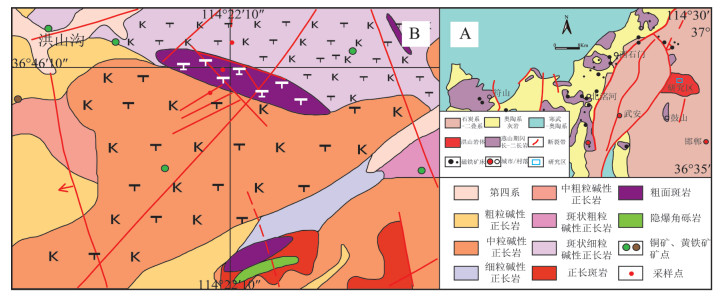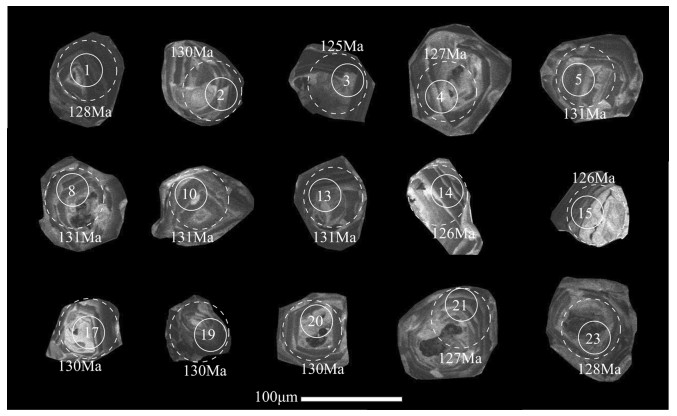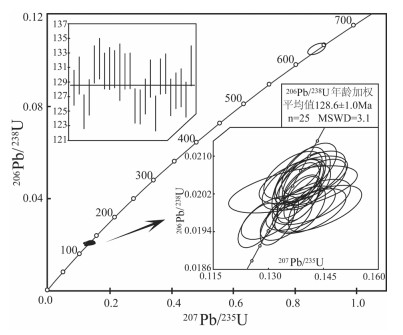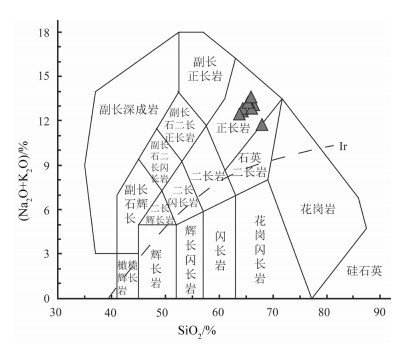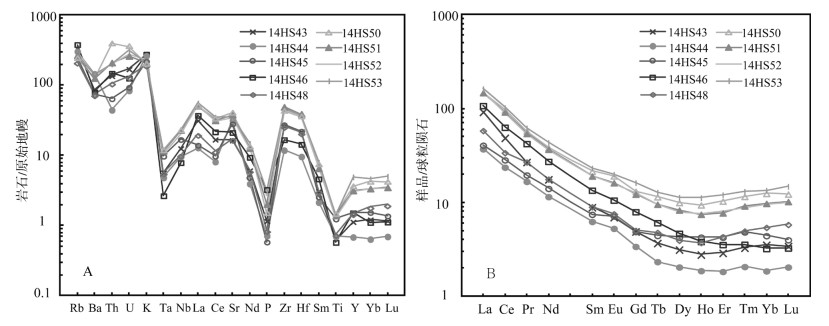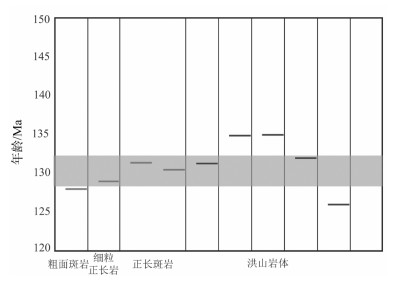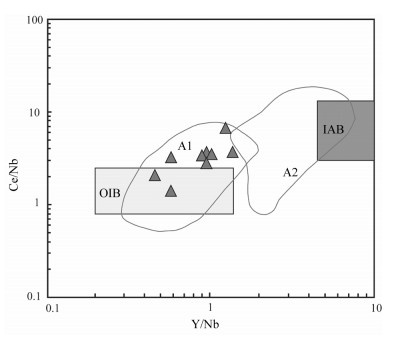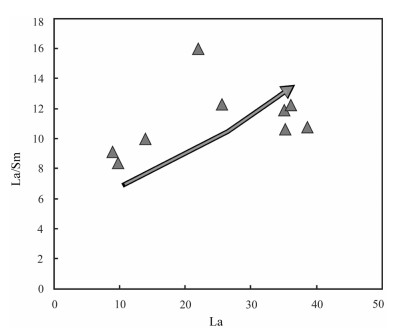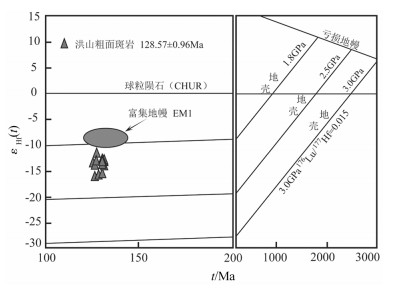Geochemistry and LA-ICP-MS zircon U-Pb dating for trachyte porphyry of Hongshan intrusion in the southern Taihang Mountains
-
摘要:
在详细野外调研的基础上, 对位于太行山南段洪山岩体中粗面斑岩的岩石学、地球化学和年代学特征进行了研究。该区斑岩中SiO2含量为63.57%~67.85%, 平均为65.19%;里特曼指数σ值为5.6~8.2;K2O/Na2O为1.00~1.74, 平均为1.24;A12O3为16.75%~18.77%, 平均为18.21%。铝饱和指数A/CNK为1.00~1.06, 属于碱性正长岩类岩石。岩石稀土元素总量(ΣREE)为33.75×10-6~144.30×10-6, (La/Yb)N=9.18~33.28, 呈现轻稀土元素(LREE)富集、重稀土元素(HREE)相对亏损的特点。δEu=0.99~1.16, 有微弱正Eu异常。在原始地幔标准化微量元素蜘蛛图解中, 样品均显示强烈富集大离子亲石元素(LILEs)、相对亏损高场强元素(HFSEs)的特征。同时, 在该地区获得的粗面斑岩LA-ICP-MS锆石U-Pb年龄为128.6±1.0Ma。锆石εHf(t)值为-16.0~-11.4, 对应的地壳模式年龄(TDM)为1258~1432Ma。这些数据表明, 洪山粗面斑岩与洪山其他中生代侵入岩是同期岩浆作用的产物, 形成于早白垩世由造山挤压环境向伸展环境转变期, 是EM1型富集地幔部分熔融形成富碱的岩浆上升侵位, 并受古老下地壳物质混染形成的。华北规模庞大的中生代岩浆作用可能与部分熔融并消耗富集岩石圈地幔层有关, 这可能也是岩石圈地幔减薄的重要方式之一。
Abstract:Based on detailed field investigation, the authors studied the petrology, geochemistry and geochronology of trachyte porphyry in Hongshan intrusion. The SiO2 and Al2O3 of the rock range from 63.57% to 67.85% and 16.75% to 18.77%, 65.19% and 18.21% on average respectively. Rittmann index(σ) ranges 5.6~8.2, the K2O/Na2O ratio ranges 1.00~1.74, with an average of 1.24. A/CNK varies from 1.00 to 1.06. These data suggest that it belongs to alkaline syenite rock. The REE content is between 33.75×10-6 and 144.30×10-6, with(La/Yb)N ratios of 9.18~33.28 andδEu of 0.99~1.16. The intrusion is remarkably characterized by enriched LREE and depleted HREE. The chondrite-normalized REE patterns show weak positive Eu anomaly. In the primitive mantle nor-malized trace element spider diagrams, the samples show strong enrichment of LILEs and relative depletion of HFSEs. In addition, tra-chyte porphyry's LA-ICP-MS zircon U-Pb dating indicates that the trachyte porphyry were emplaced at ca.128.6±1.0Ma. The zir-con εHf(t) values(-16.0~-11.4) yielded zircon Hf crustal modal ages of 1258~1432Ma. Based on the data obtained, the authors hold that Hongshan volcanic rocks originated from partial melting of an EMI-type mantle source, contaminated by LCC. Trachyte por-phyry formed in the same time as the Hongshan intrusion in the Mesozoic Cretaceous. Magmatic activities took place in the transfor-mation period of the collision environment, causing the partial melting of the mantle and producing the trachyte porphyry. This might have been one of the important ways of lithospheric mantle thinning.
-
冀北相当于辽西九佛堂组—沙海组的地层,前人称为南店组/下店组,建组剖面在冀北丰宁县森吉图下店南至青石砬南沟,岩性为暗绿色、黑色页岩、泥质粉砂岩、细砂岩和纸状页岩,底部为灰绿色含砾粗粒砂岩,厚130m。产昆虫Ephemeropsis trisetalis Eichwald与植物化石。该组不整合于花吉营组之上,与上覆青石拉组整合接触[1]。从岩性、化石及上下接触关系看,该组与辽西九佛堂组大体相当[1],但辽西九佛堂组典型化石在这里很少发现。2006—2009年,笔者等在冀北滦平县城以西安纯沟一带的山湾村、相子沟口、杨树沟口、小乔木沟下沟村,以及拉海沟北得胜岭村北山梁等多处发现丰富的叶肢介、狼鳍鱼和三尾拟蜉蝣与少量介形类等化石,自下而上共发现14层叶肢介化石,经系统研究,除一些新属种外,许多都是辽西九佛堂组—沙海组中的典型分子,证明在本区西瓜园组之上阜新组之下确实存在九佛堂组至沙海组的地层,解决了长期存在的“大西瓜园组”或“大九佛堂组”的争论,为冀北—辽西晚期中生代地层对比提供了确凿的化石证据,具有重要的地层意义。
本区九佛堂组—沙海组地层剖面位于滦平县拉海沟北马圈子得胜岭后沟山梁上,自鹞子梁砾岩底部开始向北测制,经十八盘,直到小乔木沟和小乔木沟东山梁,即为九佛堂组—沙海组。在巴克什营去滦平县的公路上,有一处山梁称鹞子梁,九佛堂组底部砾岩就以此命名为鹞子梁砾岩,与下伏西瓜园组为连续沉积。这里的砾岩较厚,达百米左右,可能为河口相沉积。笔者等从鹞子梁的鹞子梁砾岩开始向西追索至马圈子以北得胜岭东山上,砾岩仅10~20m厚,应为水下分流河道沉积。在滦平县城西瓜园以东、小南沟以西奇顺发饭庄南一小叉沟内仍可见到鹞子梁砾岩, 砾岩厚仅5m,与其下西瓜园组为连续沉积。可见,该砾岩分布较广,层位稳定,是九佛堂组底部一个明显的分层标志。笔者认为,以这层砾岩作为九佛堂组底部为宜。
前人所测得胜岭后沟-小乔木沟(也称梁根村-东山村)剖面自下而上可划分为3个岩性段。其中,一至二段为九佛堂组;三段为沙海组,详细剖面描述见参考文献[2]。
1. 地层概述
在滦平县巴克什营—滦平县公路铃铛木沟—鹞子梁出露的一段地层为西瓜园组,在其中采到了辽西尖山沟组中的重要叶肢介Eosestheria ovata(Chen)。在鹞子梁崖口处西瓜园组之上的一套砾岩,前人俗称为鹞子梁砾岩,厚数十米至百米,即九佛堂组底部砾岩。笔者等沿鹞子梁砾岩向西追索至拉海沟马圈子北得胜岭东山上,剖面即从鹞子梁砾岩底部开始向北测制,一直测到小乔木沟东山梁。自下而上可划分为3个岩性段[2]。
一段(1~7层):底部为灰白色、灰褐色厚层砾岩(即鹞子梁砾岩,即前人剖面第1层)[2]。其上以灰色、灰绿色少量深灰色中-薄层中-细粒杂砂岩为主,夹泥页岩和砂砾岩,向上见多层薄层灰岩或透镜体。厚698.91m(包括原剖面第1层)。泥页岩与钙质页岩中含丰富的化石,有昆虫Ephemeropsis trisetalis Eichwald,鱼Lycoptera cf. davidi(Sauvage)和叶肢介化石(第4层与第7层)。
二段(8~21层):底部为灰色、灰绿色中-厚层含细砾杂砂岩,厚56m。其上为灰色、灰绿色灰白色厚层-薄层砂质胶结中细粒杂砂岩,含砾石英砂岩,与泥质粉砂岩互层,夹灰黑色泥岩和页岩,厚688.41m。后者含丰富的昆虫Ephemeropsis trisetalis Eichwald,鱼Lycoptera sp.和叶肢介化石(第9~17层)。
三段(22~28层):底部为厚约30m的浅灰色厚层-块状含细砾中-粗粒杂砂岩。其上为灰色、灰绿色薄-中层中-细粒杂砂岩与泥质粉砂岩粉砂质泥岩互层,夹多层深灰色泥岩和黑色纸状页岩(油页岩)。泥岩含丰富的昆虫Ephemeropsis trisetalis Eich- wald,鱼“Lycoptera sp.”和叶肢介化石(第22~23与26岩性层)。
值得讨论的是,①关于第一层的归属问题,前人将其划归为西瓜园组顶部,但据笔者野外观察,第一层以砾岩为主,夹薄层细砂岩粉砂岩,应该是鹞子梁砾岩,从岩石地层看,应划为九佛堂组底部为宜。②关于九佛堂组与沙海组的划分问题,相当于第22层中的狼鳍鱼,为20世纪前人所定,化石点笔者也已找到,但遗憾的是当地村民不允许采集,只好作罢。是否为狼鳍鱼还有待采集研究,是否相当于第22层也值得考虑。
2. 叶肢介化石组合特征
在滦平县城以西拉海沟北的得胜岭-小乔木沟九佛堂组—沙海组剖面出露完整,化石丰富,自下而上共见到15层化石,其中叶肢介化石达14层。在得胜岭,距底部鹞子梁砾岩之上第4层(岩性分层,下同)[2]开始出现第一层叶肢介化石,有Eosestheria fuxinensis Chen, Eosestheria gracilis Niu(sp. nov.),Eosestheria cf. jiufotangensis(Chen),Diestheria ovaliformis Niu(sp.nov.)等。阜新东方叶肢介Eoses-theria fuxinensis Chen是辽西九佛堂组底部的特有分子,具有重要的地层对比意义,在本区为首次发现。Eosestheria cf. jiufotangensis(Chen)的壳瓣为长椭圆形,线距网径为0.02~0.04mm,网格有明显的纵向拉长现象,与辽西九佛堂组该种基本一致[3]。由于采集不够,这里的标本个体略小,暂定比较种。
第7层产丰富的叶肢介化石,有Eosestheria jiufotangensis(Chen),Eosestheria paucilinearis Niu(sp. nov.),Eosestheria shibapanensis Niu(sp.nov.),Eosestheria obliqua Niu(sp.nov.),Eosestheria jiuwuensis Niu(sp.nov.),Eosestheria linearis Niu(sp.nov.),Diestheria deshenglingensis Niu(sp.nov.),Diestheria striaris Niu(sp.nov.),Diestheria jiuwuensisNiu(sp.nov.),Yanjiestheria desheng-lingensis Niu(sp.nov.), 等。其中,Eosestheria jiufotangensis Chen个体巨大,长椭圆形-长卵形,线距网径为0.02~0.04mm,网格有纵向拉长现象,与辽西九佛堂组的该种模式标本基本一致,也是该种在冀北地区相当层位中首次发现。其他种都是新种,其中叠饰叶肢介属较发育,并以Diestheria deshenglingensis Niu(sp.nov.)数量较多,最具代表性。延吉叶肢介Yanjiestheria属开始出现,但数量极少。Yanjiestheria deshenglingensis Niu(sp. nov.)是该属出现的最低层位。
其上的第9~10层以叠饰叶肢介属为主,仅有少量东方叶肢介。该层位覆盖较大,有待详细采集。其中,采到一新属种——滦平承德叶肢介(将另文发表)等。
第13~17层以东方叶肢介属占主导,有Asioestheria(=Eosestheria)tuanshanennsis W. Wang,Eosestheria shanwanensis Niu(sp.nov.),Eosestheria yangshugouensis Niu(sp.nov.),Eosestheeria changshanziensis W.Wang,Yanjiestheria shanwanensis Niu(sp.nov.),Yanjiestheria ancungouuensis Niu(sp. nov.),Diestheria sp.,Neimongolestheria sp.等。其中,见较多辽西九佛堂组中的种,如Asioestheria (=Eosestheria)tuanshanensis, Eosestheria changshanziensis等,具有重要的地层对比意义[3]。这里的延吉叶肢介Yanjiestheria数量很少,与东方叶肢介群具共生关系。
第22层有2属3种,以叠饰叶肢介属为主,有Diestheria yangshugouensis Niu(sp.nov.),D. xiaoqiaomugouensis(sp.nov.),Jiliaoestheria xiaoqiaomugouensis(sp.nov.),总体看,属种较单调。其中,Jiliaoestheria xiaoqiaomugouensis(sp.nov.)是该属延伸的最高层位,似为孑遗分子。
第23层全部是延吉叶肢介Yanjiestheria 属;26层也以该属占绝对优势,仅残存极少量的东方叶肢介和叠饰叶肢介,有Yanjiestheria xiaoqiaomugouensis Niu(sp.nov.),Y. adornata W.Wang,Y. vetusta W/ wang,Y. binggouensis W. Wang, Eosestheria magna Niu(sp.nov.),E. beizhuianchengziensis W. Wang, Diestheria sp.等。其中,Y. adornata,Y. vetusta,Y. binggouensis 见于建昌冰沟沙海组;Eosestheria beizhuanchengziensis见于辽西清河门北砖城子沙海组,均为辽西建昌盆地沙海组中的典型分子[3],具有重要的地层对比意义。
3. 滦平盆地九佛堂组—沙海组叶肢介化石组合序列与生物地层划分
综上所述,可将本区九佛堂组—沙海组自上而下初步划分为5个叶肢介组合,沙海组为2个叶肢介组合,自上而下为:
(1)沙海组(等于原九佛堂组三段22~28层[2])
Yanjiestheria xiaoqiaomugouensis-Y. adornata 组合(带):该组合以延吉叶肢介Yanjiestheria属占绝对优势,并见有4个辽西建昌盆地沙海组中的典型分子,其中,Yanjiestheria adornata,Y. vetusta, Y. binggouensis可与辽西建昌盆地沙海组对比。
Diestheria yangshugouensis- D. xiaoqiaomugouensis组合(带):为沙海组底部的一个化石组合,属种单调,均为叠饰叶肢介,与辽西沙海组下部大体相当。
(2)九佛堂组(等于原九佛堂组一、二段1~21层)[2]
Chengdestheria luanpingensis-E. lata组合(带):以叠饰叶肢介为主,为九佛堂组顶部的一个化石组合。
Eosestheria tuanshanensis-E.changshanziensis 组合(带):该组合有辽西九佛堂组中的2个重要分子,具有重要的地层对比意义。其他一些为新种,总体上可与辽西朝阳-义县九佛堂组对比。但是,由于采集的不够详细,进一步的生物分带还有待深入研究。
Eosestheria fuxinensis-Eosestheria jiufotangensis组合(带):该组合(带)相当于原九佛堂组一段1~ 7层[2],以Eosestheria 属较发育为特征,Eosestheria fuxinensis,Eosestheria jiufotangensis 在本区为首次发现,它们是辽西喀左九佛堂九佛堂组中的典型分子,可与辽西九佛堂组下部对比。
4. 滦平盆地九佛堂组—沙海组的地层对比与时代
根据滦平盆地和辽西建昌、阜新—义县地区的区域资料,Eosestheria fuxinensis 均出现在九佛堂组(相当于泥河子组)底部,其区域分布广,层位稳定,易于识别,故九佛堂组以Eosestheria fuxinensis 的首现为生物地层标志。另一个重要分子是Eosestheria jiufotangensis,也是九佛堂组的重要分子[3]。Eosestheria tuanshanensis,E.changshanziensis 等在本区出现的层位略高,总体分布于九佛堂组中下部,剖面1~21层可以与辽西九佛堂组对比。
沙海组在冀北滦平和辽西建昌均以延吉叶肢介Yanjiestheria属的繁盛为特征,其中,以Yanjiestheria adornata, Y. xiaoqiaomugouensis,Y. binggouensis, Y. vetusta等多个种的组合为特征,完全可以与义县杨柳屯、上齐台、清河门、朝阳梅勒营子,以及建昌冰沟的沙海组对比[3]。目前未见沙海组中的重要分子Pseudestherites属,值得注意采集。
在辽西喀左-建昌盆地和阜新-义县盆地,九佛堂组—沙海组的生物地层标志以双壳类和介形类为主[2-3],本区则未见这些双壳类,可能水体略深的缘故。这里的沙海组也未见煤线或煤层,仅见深灰色含炭纸状页岩,可能相变为油页岩,两地地层如何对比也有待进一步研究。
5. 九佛堂组与沙海组的由来
1933—1934年,日本学者远藤隆次将辽西建昌盆地九佛堂附近玄武岩之上含Lycoptera 鱼化石的一套砂页岩命名为九佛堂统,时代归为早白垩世。其后,该名称广泛用于冀北—辽西地区,但在命名剖面该组未见顶。1962年,中国古生物学家顾知微将辽西含狼鳍鱼Lycoptera 岩系称为热河群,其中,包括九佛堂组,时代为晚侏罗世[4]。1970年,辽宁区调一队以辽西西部的九佛堂组代替阜新—义县地区的沙海组,统称九佛堂组。1987年,前人将建昌县城东至冰沟煤矿剖面顶部22.99m的黄灰色含砾粗沙岩及粉砂岩与煤线划归冰沟组或沙海组[4],在辽西就把相当于九佛堂组的沙海组置于九佛堂组之上,把辽西建昌盆地与阜新-义县盆地的同一套地层改为上下关系,出现了岩性对岩性、煤层对煤层的做法。笔者认为,辽西建昌盆地九佛堂组由粗-细-粗,形成一个完整的沉积旋回,仅最上部变粗的砂砾岩夹有煤层。也就是说,九佛堂组晚期甚至中晚期开始成煤,这与内蒙固阳盆地的固阳组和甘肃酒泉盆地的赤金堡组一样,也含煤层。按现行的划分方法,在义县组火山岩之上与阜新组之下的一套地层统一划分为九佛堂组—沙海组,本文暂以此划分方案。但笔者等更倾向于统称九佛堂组而去除沙海组一名为好[3]。
6. 中国北方晚期中生代陆相沉积盆地演化与陆相建阶问题的讨论
6.1 中国北方晚期中生代陆相沉积盆地演化
6.1.1 新疆准格尔盆地吐谷鲁群[5-6]
晚期中生代地层吐谷鲁群自下而上为清水河组砾岩、含砾砂岩、泥岩等,呼图壁河组为紫红色、灰绿色砂质泥岩夹砂岩与灰岩,胜金口组为灰绿色砂岩、砂质泥岩夹灰岩,连木沁组为杂色砂质泥岩、粉砂岩夹砂岩,底部与顶部分别与下伏上侏罗统喀拉扎组和上白垩统东沟组呈假整合接触关系。从粗碎屑砾岩砂岩开始沉积,粒度逐渐变细,并夹灰岩,反映沉积盆地由发生到逐渐扩展,直至上升隆起的完整过程。
6.1.2 酒泉盆地赤金桥组、赤金堡组与新民堡组[7]
晚期中生代地层自下而上为上侏罗统博罗组(相当于土城子组)和下白垩统赤金桥组、赤金堡组与新民堡组。赤金桥组下部为紫红色砾岩段,中部为石英砂岩-泥页岩段,上部为硬砂质长石砂岩段,由粗-细-粗形成一个完整的沉积旋回,反映由断陷沉降开始,到水盆扩大再到整体隆升的震荡环境。赤金堡组下部为紫红色砾岩段,中部为黄褐色、灰绿色长石砂岩段,上部为深灰色、灰黑色泥页岩夹泥灰岩段,由粗-细-细,粒度逐渐变细,并夹泥灰岩,形成一套完整的沉积旋回,也反映地壳运动的持续下降与逐渐隆升的过程。新民堡组下部巨厚的紫红色砾岩段,上部黄褐色灰绿色、深灰色紫红色等杂色砂岩、泥页岩夹砾岩,也由粗-细-粗形成完整的沉积旋回,反映地壳运动由持续隆升-下降-隆升的震荡性质。赤金桥组、赤金堡组与新民堡组又由粗-细-粗形成更高一级的沉积旋回。
6.1.3 宁陕六盘山群/志丹群[5]
六盘山群三桥组与志丹群宜君组均为砾岩,六盘山群和尚铺组与志丹群洛河组为中细粒砂岩,六盘山群李洼峡组-马东山组-乃家河组与志丹群环河组-罗汉洞组-泾川组以泥页岩夹灰岩为主,局部含石膏,由粗-细-细,形成一套完整的沉积旋回,反映地壳运动持续隆升与沉降的过程。
6.1.4 冀北滦平盆地[8]
假整合于上侏罗统土城子组/后城组之上的是张家口组酸性火山岩与大北沟组沉积岩,从火山喷发到火山碎屑湖相沉积,形成一个完整的火山-沉积旋回。整合于大北沟组之上的地层依次为大店子组、西瓜园组、九佛堂组-沙海组,与其上的阜新含煤组(青石砬组)整合接触。大店子组以蜂窝梁砾岩开始,砂岩-泥页岩-砂砾岩,由粗-细-粗形成第一个沉积旋回。以龙层砾岩开始,砂砾岩-砂岩-泥页岩夹泥灰岩,由粗-细形成第二个沉积旋回。以拉海梁砾岩为标志,西瓜园组从砾岩、凝灰质砂砾岩夹基性火山岩、砂岩、泥页岩,到砂页岩夹砂砾岩,由粗-细-粗形成又一个完整的沉积旋回,反映地壳从隆升转为下降,最后又隆起的完整过程。九佛堂组-沙海组以鹞子梁砾岩开始了一个新的沉积旋回,从砂砾岩-泥页岩夹泥灰岩,到含砾砂岩与泥质粉砂岩互层,局部夹油页岩,完成了又一个沉积旋回。其上与阜新组/青石砬组为整合关系。青石砬组为灰黄色、黄褐色砾岩、砂砾岩与泥页岩,夹煤层,地壳开始上升,水盆逐渐沼泽化,为温暖湿润气候下的一套煤系地层。从土井子组开始,气候变得炎热干燥,为一套红色砾岩砂砾岩沉积,形成另外一套沉积旋回。
6.1.5 辽西义县组-九佛堂组-沙海组-阜新组[9-10]
明显不整合覆于上侏罗统土城子组之上的义县组底部火山角砾岩或基性火山岩发生的火山喷发,经陆家屯层、尖山沟层、上园层、大康堡层、大王仗子层、金刚山层等火山间歇期,形成一套喷发-沉积-再喷发-再沉积的喷发-沉积旋回。九佛堂组—沙海组以砾岩或黄花山火山角砾岩覆于义县组之上,之后为砂岩、泥页岩,逐渐过渡为沙海组的砂砾岩夹煤层,由粗-细-粗形成一套完整的沉积旋回。阜新组为一套砾岩-砂岩-泥页岩夹多层可采煤层,形成又一个成煤沉积旋回,反映沉积盆地逐渐萎缩并沼泽化的完整过程。继而以孙家湾组红色粗碎屑堆积结束了辽西下白垩统的沉积。
综上所述,中国北方晚期中生代沉积盆地演化有以下特点。
(1)在中国东部环太平洋带,每个岩石组几乎均从底砾岩开始,以洪积相、河流相或水下分流河道相开始,标志着盆地的形成。进而由粗到细,再到粗,或由粗到细再到更细,形成一个完整的沉积旋回,晚期盆地隆升而结束该时期盆地的发展历史。接着,另一个沉积盆地又以类似的沉积旋回,由粗-细-粗叠加在另一个岩石组之上。在一个地区,可以有多个沉积旋回的岩石组,最后,以整个盆地萎缩并形成河湖沼泽相成煤而结束。
值得注意的是,冀北地区晚侏罗世土城子组总体由砾岩-细砂粉砂岩泥岩-砾岩、由粗-细-粗变化,可分为3个岩性段,辽西地区则分为4个岩性段。细砂粉砂岩与泥岩产叶肢介、鱼、恐龙、植物等化石。在滦平盆地,张家口组-大北沟组-大店子组的沉降中心在西部的火斗山乡张家沟门一带,而不在东部的大店子—大北沟地区。西瓜岩组下部虽然仍在西部的拉海沟地区,各类化石也很丰富,但从中上部开始,沉降中心转移到东部的西瓜园一带,并有超覆现象。九佛堂组—沙海组的沉降中心又向西转移至滦平县城西部安纯沟地区。青石拉组成煤地层以北部的丰宁县一带最好,沉降中心已出了滦平盆地。
(2)在中国西部内陆区,每个组的底部多以干燥炎热气候强氧化环境下的紫红色粗碎屑底砾岩为特征,并以河流相或洪积相为特点,形成多个岩组的连续沉积,是划分岩组的良好沉积标志[7]。但在中国东部环太平洋区气候多湿润,如冀北的蜂窝梁砾岩-龙层砾岩-拉海梁砾岩-鹞子梁砾岩、土井子组砾岩多黄褐色-灰色等。但也不妨碍以此为标志进行岩石分组。
(3)进入侏罗纪后,中国北方基本上为陆相沉积,即板块内的构造运动。从各沉积盆地的发育历史分析,中国北方以板内褶皱凹陷或断陷盆地为特征,并表现为持续的震荡性质。这种震荡性质使得一个地区的沉积盆地形成多个沉积旋回,也就形成多个岩石组。这是由具震荡性质的断陷-上升的构造运动控制,是自然历史过程造成的,而不是人为的岩石分组,即所谓地壳运动的多旋回特点。总之,地壳的震荡性与陆相沉积盆地的旋回性是中国北方晚期中生代沉积盆地演化的最大特点。
(4)中国北方陆相地层的划分和对比与海相地层的岩石分组有很大不同。海相多以岩性的变化加之古生物组合的不同来分组,而陆相地层明显受地壳构造运动的震荡性质控制,是以完整的沉积旋回完成一个岩组的。因而,不能套用海相分组的惯例来划分陆相的岩石组或陆相阶的建立。
6.2 中国北方晚期中生代陆相建阶问题
国际上年代地层单元有界、系、统、阶, 是基于生物发展阶段性原理和不可逆性原理自然划分的,大的时间间隔生物表现为大的发展阶段,小的时间间隔则表现为小的发展阶段,阶的建立是较小发展阶段最小的年代地层单元。阶是统的再分,一个统可以有一个阶或多个阶。阶是生物带的集合,生物带是阶的再分,是建立阶的最基本的生物基础。
所谓生物带,是某一个或几个生物属种在其生活的地质时期内形成的地层体[11]。目前,原则上阶应适合于世界范围内,但在有些情况下,只有某些微体化石可具全球对比意义,特别是陆相阶仍然具有大区性或某些生物地理区的性质,海相阶是这样,陆相阶可能更是这样。海相生物带的划分与年代地层阶的建立因海盆广大、环境稳定、化石丰富、演化迅速,最符合这一基本概念。陆相水盆较小、环境变化较大,生物生存连续性不是很好,给生物带的建立带来一定困难。但笔者对中国北方晚期中生代陆相地层进行了长期研究发现,陆相地层沉积旋回性与韵律性明显,不含化石的较粗碎屑岩与含化石的较细粒碎屑岩或泥页岩夹灰岩等经常交互出现,适合某些生物生存的生活环境重复出现,给这些生物连续生存创造了条件,某些生物演化的阶段性也就表现了出来,为陆相生物带的建立与划分提供了客观条件,也为陆相阶的建立提供了生物基础。因此,笔者提出陆相地层生物带建立的基本条件是:①地层剖面出露连续、暴露完全、顶底清楚、不能有间断存在;②沉积旋回性与韵律性明显,某些生物生存环境反复出现,为生物演化提供了必要条件;③化石丰度与分异度大,某些属种演化的阶段性就表现了出来,为生物带的建立与划分提供了条件;④在区域上有较广泛的分布,为大区性的陆相年代地层阶的建立提供了生物地层基础。只要具备这些条件,陆相生物带的划分和陆相阶的建立完全可以做到,也完全符合生物带的划分与阶的建立的基本概念。其实,海相地层的划带建阶也要求这些条件,海相阶与陆相阶在本质上完全一致[12],生物发展的阶段性原理和不可逆性原理就是它们的共同基础。
6.3 中国北方晚期中生代陆相阶的建立
根据上述建阶的基本条件和基本概念,结合前人资料,笔者将中国北方晚期中生代陆相阶由老到新拟确认或初步建立如下。
6.3.1 三宝营阶
该阶为中国地质科学院地质研究所王思恩研究员所建,单位层型剖面在辽西北票三宝营乡刘家沟,源于岩石地层单元土城子组[13],与下伏髫髻山组假整合,与上覆义县组不整合。根据植物、孢粉、介形类、叶肢介、昆虫、脊椎动物等,将三宝营阶的时代定为晚侏罗世早—中期,即牛津期—基默里期(Oxfordian—Kimmeridgian)。特别值得注意的是,王思恩仔细观察了美国西部上侏罗统莫里逊组(Morrison Formation)的叶肢介化石,认为与土城子组中的Pseudograpta 极相似,两者可以对比[13]。辽西土城子组所产介形类小怪介Cetacella 也见于莫里逊组,该属在世界范围内主要见于晚侏罗世基默里期,故三宝营阶的时代似应属晚侏罗世。最近,笔者在河北宣化堰家沟后城组首次发现川街叶肢介属(Chuanjieestheria Niu, 2005),该属原产地为云南上侏罗统麻地山组—安宁组[14-15],也证明环太平洋带的后城组(相当于土城子组)与中国西南地区滇中特提斯区海陆交互相中—上侏罗统的对比又有了古生物化石方面的有力证据[15]。据此,宣化堰家沟后城组的层位可能要低些。叶肢介生物分带由新到老为:③ Yanshanoleptestheria-PingquaniaLingyuanella 组合(带);②Pseudograpta-Monilestheria-Sinograpta 组合(带);①Chuanjieestheria elliptica-Ch. yanjiagouensis-Ch. xuanhuaensis组合(带)。
介形类组合带自上而下为[16]:②上部组合:Djungarica yangshulingensis-Mantelliana reniformisStenestroemia yangshulingensis 组合(带)/ Djungarica-Mantelliana-Damonella-Stenestroemia 组合(带);①下部组合:Cetacella substriata-Mantelliana alta-Darwinula bapanxiaensis组合(带)。
同位素底界年龄为141±1.3Ma,顶界年龄137.3± 1.0Ma,王思恩等[13]认为其时代为晚侏罗世早—中期,即牛津期—基默里期(Oxfordian-Kimmeridgian)。
以叶肢介Chuanjieestheria elliptica-Ch. yanjiagouensis-Ch. xuanhuaensis组合(带)的首现为标志,即为三宝营阶的开始[15]。
相当于三宝营阶的岩石地层有土城子组、后城组、天池河组、芬芳河组、享堂组、采石岭组、博罗组、喀拉扎组等。喀拉扎组下伏齐古组年龄为161.8Ma[17]。
6.3.2 榆树下阶
榆树下阶为本文所建,单位层型剖面位于滦平县火斗山乡张家沟榆树下村[12]。榆树下地区自下而上可见髫髻山组、土城子组、张家口组、大北沟组、大店子组和西瓜园组。其中,在张家沟门土城子组之上的“张家口组”经笔者2015年重测厚度仅为209.57m,与下伏土城子组假整合,与大北沟组一段含砾凝灰岩、凝灰岩、凝灰质砂砾岩与砂岩为逐渐过渡关系。最近,经中国地质大学(北京)重新测制大北沟组,可见70余层火山凝灰岩/斑脱岩或流纹岩夹层。在区域上,张家口组与大北沟组为相变关系[18]。据此,在张家沟地区笔者建议将这里的“张家口组”与大北沟组一段合并,统称大北沟组一段。根据大胎壳叶肢介属Magumbonia Wang的等时对比,厘定后的大北沟组一段大体上相当于内蒙古哲里木盟扎鲁特旗上侏罗统满克头鄂博组[18]。满克头鄂博组产双壳类“Ferganoconcha ”(Arguniella)spp.;植物Ginkgo sp., Baiera gracilis, Coniopteris sp., Cladophlebis sp., Phoenicopsis sp., Zamites sp.;昆虫Ephemeropsis trisetalis 等。Rb-Sr等时线年龄为160.29± 14.39Ma[19]。其中,昆虫三尾拟蜉蝣和额尔古纳蚌也产于大北沟组,将厘定后的大北沟组一段与二、三段连在一起,在区域上也有相同的古生物化石依据了。
榆树下阶的典型剖面在滦平县火斗山乡张家沟榆树下村,产叶肢介、介形类、双壳类、北票鲟、鲎虫、昆虫三尾拟蜉蝣、有尾两栖类(大店子东沟与围场西顺井)、鸟类(围场西顺井与丰宁)、植物等,以叶肢介和介形类生物带最典型。叶肢介自上而下分为[12]:③Yanshania xishunjingensis-Y. subovata(顶峰)带;②Nestoria pissovi-Keratestheria gigantea(共存延限)带;①Nestoria pissovi-Jibeilimnadia ovata (共存延限)带。
介形类化石组合带为Luanpingella-TorininaEoparacypris 组合带[20-22],分为:②Torinina-obesa 亚带;①Luanpingella postacuta亚带。该介形类组合带最初仅限于大北沟组三段。2014年以来,中国地质大学(北京)又在二段也找到了介形类化石,初步鉴定有Luanpingella postacuta, Eoparacypris jingshangensis, Pseudoparacypridopsis luanpingensis, Rhinocypris subechinata, Darwinula legunianela, D. dadianziensis, Yanshanina dabeigouensis等(待刊)。
榆树下阶以Nestoria pissovi-Jibeilimnadia ovata, 的首现为生物标志。据前人资料,榆树下剖面第三段底部锆石U-Pb年龄为133.9±2.5Ma[23],推测榆树下阶顶部同位素年龄约为133Ma。榆树下阶底部同位素年龄约为137.3±1.0Ma,延时约4.3Ma,其时代似为晚侏罗世最晚期提塘期(Tithonian)[18]。
与榆树下阶相当的岩石地层有冀北大北沟组(包括滦平盆地归于大北沟组一段的张家口组),内蒙古大兴安岭地区的木瑞组,满克头鄂博组-玛尼吐组-白音高老组、宝石组、多伦组,张家口地区的张家口组,俄罗斯外贝加尔额尔古纳河左岸的额尔古纳组下亚组-乌斯基-卡尔组等[18]。
6.3.3 张家沟阶
张家沟阶为中国地质科学院地质研究所田树刚等所建,源于岩石地层单元大店子组[23]。单位层型剖面位于滦平县火斗山乡张家沟下营村—上营村,底部界线层型在滦平县火斗山乡张家沟下营村和张家沟小东沟。在张家沟小东沟,蜂窝梁砾岩厚仅0.5m,与榆树下阶为连续沉积[24],并以蜂窝梁砾岩为岩石标志,以Cypridea stenolonga Subz.的首现与叶肢介Eosestheria antiqua 的首现为生物标志,也以狼鳍鱼的首现为特征。富产双壳类、腹足类、介形类、叶肢介、昆虫、鱼类、恐龙等。其中,以介形类和叶肢介生物带较典型。
介形类生物带自上而下为[20-22]:⑤Cypridea shangyingensis 亚带(大店子组四段);④Cypridea sulcata亚带(.大店子组三段);③Cypridea luanpingensis 亚带(大店子组二段);②Cypridea xitaiyangpoensis 亚带(大店子组一段上部);①Cypridea stenolonga 亚带(大店子组一段下部)。
叶肢介生物带自上而下为[24]:⑤Jiliaoestheria striaris 带(大店子组四段);④Jiliaoestheria elliptica带(大店子组三段);③Eosestheria donggouensis 带(大店子组二段);②Eosestheria zhangjiagouensis 带(大店子组一段上部);①Eosestheria antique 带(大店子组一段下部)。
张家沟阶是介于榆树下阶与李营阶之间的一个阶,同位素年龄推测为133~128Ma[25],其时代为早白垩世贝里阿斯期(Berriasian)[20-22]。与其相当的岩石地层有冀北地区的大店子组和新疆的吐谷鲁群清水河组[5]。新疆吐谷鲁群的时代目前尚有分歧,有待深入研究。
6.3.4 李营阶
李营阶为本文所建,源于岩石地层单元西瓜园组。在滦平火斗山乡拉海沟北的马圈子村,李营阶与下伏张家沟阶为连续沉积,其界线层型在拉海沟北的马圈子村,产双壳类、介形类、腹足类、叶肢介、昆虫、虾类、狼鳍鱼、北票鲟、植物等化石[23, 26]。李营阶底部以拉海梁砾岩为岩石标志,以奇异环足虾(Cricoidoscelosus aethus)与卵形东方叶肢介(Eosestheria ovata)的首现为生物标志。在马圈子村,李营阶向上水盆变浅,很少有化石,沉降中心向东转移至县城以东西瓜园李营一带,在李营至岩青沟,西瓜园组产极为丰富的狼鳍鱼、双壳类、腹足类、介形类、叶肢介、北票鲟、辽宁古果等化石。其中,叶肢介化石多达21层,自上而下可连续划分为5个叶肢介带[26]:⑤Eosestheria aff. middendorfii-E. persculpta(共存延限)带(, 李营剖面西瓜园组三-四段);④Eosestheria xiguayuanensis-E. xiaolanggouensis (共存延限)带, (李营剖面西瓜园组一段上部);③Diestheria yixianensis-D. longiqua(共存延限)带, (李营剖面西瓜园组一段中部);②Diestheria jeholensis带(马圈子剖面西瓜园组一段下部);①Eosestheria ovata 带(马圈子剖面西瓜园组一段近底部)。
以上①、②、③、⑤带叶肢介,以及奇异环足虾、辽宁古果等均见于辽西义县组沉积岩夹层中[10],西瓜园组是义县组火山岩在滦平盆地的相变。因此,阶的建立应以单一岩相沉积岩为阶的单位层型,而不应以火山岩地层为标准来建阶。但值得指出的是,在辽西义县组沉积岩夹层中产大量的鱼类、两栖类、龟类、恐龙类、鸟类、兽类,以及原始被子植物等,涉及鸟类起源、被子植物起源等重大科学问题,引起国际科学家和国际媒体的广泛关注,义县组似可作为副层型,李营阶是值得重视的一个阶。
李营阶的时代大体为早白垩世凡兰吟期(Valanginian),同位素年龄推测为128~120Ma[23, 25]。与李营阶相当的岩石地层有冀北的西瓜园组和花吉营组、辽西的义县组、吉林营城的火石岭组、延吉的屯田营组、甘肃酒泉盆地的赤金桥组等。不同化石门类有不同的时代意见,有待统一认识。
6.3.5 鹞子梁阶[2]
源于冀北—辽西的南店组或九佛堂组,为本文所建,典型剖面位于河北省滦平县巴克什营-滦平公路鹞子梁以西得胜岭-小乔木沟剖面。在辽西,九佛堂组与其下的李营阶义县组火山岩为沉积间断的假整合关系,而在鹞子梁与得胜岭,其与下伏李营阶的西瓜园组为连续沉积,因此,该阶的典型剖面似应定于滦平盆地。
在滦平盆地,该阶产叶肢介、介形类、昆虫、狼鳍鱼(?)、恐龙脚印、植物等化石,而在辽西建昌盆地与义县盆地,产丰富的双壳类、腹足类、介形类、昆虫、鱼类、龟类、恐龙类、鸟类、植物等化石。根据生物分带建阶的基本原则,即阶与阶之间应该为连续沉积,鹞子梁阶暂建于滦平盆地。其中,叶肢介极丰富,自上而下初步建立3个化石带。
(3)Chengdestheria luanpingensis-Eosestheria. lata组合(带):初步采集以叠饰叶肢介为主,为九佛堂组顶部的一个化石组合。
(2)Eosestheria tuanshanensis-E.changshanziensis组合(带):该组合有辽西九佛堂组中的2个重要分子,具有重要的地层对比意义。其他一些为新种,总体上可与辽西朝阳-义县九佛堂组对比。但是,由于采集的不够详细,进一步的生物分带还有待深入工作。
(1)Eosestheria fuxinensis-Eosestheria jiufotangensis组合(带):该组合(带)相当于原九佛堂组一段1~ 7层[2],以Eosestheria属较发育为特征,Eosestheria fuxinensis, Eosestheria jiufotangensis在本区为首次发现,它们是辽西喀左九佛堂九佛堂组中的典型分子,可与辽西九佛堂组下部对比。
鹞子梁阶以鹞子梁砾岩开始为岩石标志,以叶肢介Eosestheria fuxinensis-Eosestheria jiufotangensis组合(带)的首现为生物标志。根据叶肢介化石推断,其时代为早白垩世欧特里夫期(Hauterivian)—巴列姆期(Barremian)[27-28]。
与鹞子梁阶相当的岩石地层有辽西的九佛堂组、冀北的南店组(现统一改为九佛堂组),宁陕的志丹群/六盘山群,甘肃酒泉盆地的赤金堡组中下部[7]与河口群。新疆吐谷鲁群的时代目前尚有分歧,认为介形类可与九佛堂组—沙海组对比,叶肢介可与九佛堂组—阜新组对比[29],有待深入研究。
6.3.6 清河门阶[30]
源于辽西义县清河门沙海组的煤系地层,与下伏九佛堂组和上覆阜新组煤系均为连续沉积,以产叶肢介和植物化石为主。其中,在辽西义县杨柳屯煤矿产叶肢介Neimongolestheria prolixa W.Wang, N. yangliutunensis(Chen);清河门Pseudestherites qinghemenensis Chen;清河门北砖城子Eosestheria beizhuanchengziensis W.Wang, Asioestheria meileyingziensis W.Wang;清河门乱叉子沟Yanjiestheria vasiformis W.Wang;义县上齐台Neimongolestheria shangqitaiensis W.Wang;朝阳梅勒营子Yanjiestheria pusilla Chen, Paraliograpta intermedioides W.Wang;建昌冰沟Yanjiestheria venusta W.Wang, Y. adornata W.Wang, Y. binggouensis W.Wang, Pseudestherites jianchangensis W.Wang等[30]。在滦平盆地,沙海组与下伏九佛堂组和上覆阜新组均为整合接触,自下而上可划分2个叶肢介带,如上述,完全可以与辽西建昌沙海组(相当于冰沟组)对比。
从岩石地层分析,九佛堂组—沙海组粒度由粗-细-粗,形成一个完整的沉积旋回,沙海组是盆地上升过程中的上部层位,理应归于一个岩石地层单元,统称九佛堂组为宜[2]。但是,从生物组合看,区域上均以延吉叶肢介为主,热河生物群中的东方叶肢介基本绝灭,未见狼鳍鱼等,暂时另立一个阶,以示早于阜新含煤组的一个含煤岩段和另外一个新的叶肢介动物群开始繁盛。
以叶肢介Yanjiestheria-Pseudestherites-Diestheria 组合为特色。双壳类为Tetoria yixianensis,T. cf. yokayama, Nippononaia cf. tetoriensis,N. sinensis,Mesocorbicula tetoriensis,Nakamuranaia chingshanensis 等,介形类Cyoridea(Ulwellia)ihsenensis-Limnocypridea qinghemenensis-Protocypretta subglobosa 组合,植物属Acanthopteris gothani-Nilssonia sinensis组合。
根据双壳类,鹞子梁阶的时代可能为早白垩世凡兰吟期(Valanginian)[31];根据叶肢介Yanjiestheria-Migransia 组合,其时代为巴列姆期((Barremian))[28]或阿普特晚期。不同化石门类尚有不同意见,有待深入研究。
与沙海组相当的岩石地层有辽西—冀北的沙海组、松辽盆地的沙河子组、黑龙江鸡西的城子河组、内蒙古的大磨拐河组和固阳组下部、甘肃酒泉盆地的赤金堡组上部含煤层[7]等。
6.3.7 海州阶[5, 29]
源于辽西下白垩统阜新组,以阜新海州露天煤矿剖面最典型,故以此命名。岩性为砾岩、砂砾岩、砂岩、页岩夹多层可采煤层,为一套水盆地逐渐上升萎缩并沼泽化的沉积。产植物、孢粉、介形类、双壳类等化石。
植物群为Acanthopteris gothani-Nilssonia sinensis组合;孢粉为Deltoidospora-Cicatricosisporites-Appendicisporites 上组合,Pilosisporites-Appendicisporites-Triporoletes 下组合;介形类上部为Mongolocypris globra-Candona dongliangensis 组合,下部为Cypridea(C.)tumidiuscula-Pinnocypridea dictyodroma组合。
时代可能为早白垩世阿尔必早期(Early Albi- an)[29]。与其相当的岩石地层有鸡西—延吉地区的穆棱组和长财组、松辽区的营城组、辽西的阜新组、冀北的青石砬组、内蒙古的固阳组、松辽盆地的登楼库组、甘肃酒泉盆地的新民堡组下部(相当于新民堡组下沟段[7])等。
6.3.8 “孙家湾阶”
值得讨论的是,辽西的孙家湾组、冀北的土井子组、松辽盆地的登楼库组等以杂色砾岩砂砾岩开始,为一套干旱气候条件下的粗碎屑沉积,形成另外一个新的沉积旋回。孙家湾组产腹足类、介形类和植物等化石,土井子组产双壳类、介形类、叶肢介、脊椎动物等[1]。前人曾建”孙家湾阶”, 其时代为阿尔必晚期[5, 29],有待今后深入研究。
与其相当的岩石地层有辽西的孙家湾组、冀北的土井子组、松辽盆地的登楼库组、甘肃酒泉盆地的新民堡组上部(相当于新民堡组中沟段[7])。
6.4 对中国第四届全国地层会议提出的《中国地层表》(试用稿)的讨论
6.4.1 上侏罗统未建阶土城子组
表中给出的年龄为163.5±1~145.0±0.8Ma,延时高达18.5Ma。从地层厚度与粗碎屑岩为主的一套红色地层的沉积速率分析是不可能用时如此之多。前人对土城子组同位素SHRIMP锆石U-Pb测年结果为141.7 ± 1.3~137.3 ± 1.0Ma或142.6 ± 1.3~136.4±1.9Ma[13],延时仅为4.4~6.2Ma。《中国地层表》中给出的年龄值还有待研究。
6.4.2 关于“冀北阶”
笔者将滦平盆地的“张家口组”一并归于大北沟组一段,形成一套完整的火山喷发-沉积旋回,符合前人认为的两者为横向相变关系[18],统一建立榆树下阶单位层型。由于大北沟组一段与下伏土城子组为平行不整合,目前无法建立界线层型。
6.4.3 关于“热河阶”与“辽西阶”
源于大店子组的张家沟阶、源于西瓜园组的李营阶、源于九佛堂组的鹞子梁阶和源于沙海组的清河门阶,以及源于阜新组的海州阶,都是从一个沉积盆地发生、发展到萎缩消亡的完整过程,再代之以新的沉积盆地的形成。新的盆地会出现新的生活环境,新的生活环境就有可能产生新的生物群落,从而形成生物发展的阶段性,为生物带的划分与阶的建立提供生物基础。所谓“热河阶”实际上包括张家沟阶、李营阶与鹞子梁阶3个阶。同样,所谓“辽西阶”包括了清河门阶、海州阶及原“孙家湾阶” 3个阶。
由上述可知,张家沟阶是东方叶肢介群开始辐射的初级阶段,个体较小,线距网径也较小,多在0.02~0.04mm。李营阶是东方叶肢介群最繁盛的阶段,个体较大,线距网径也较大,可达0.04~ 0.08mm。鹞子梁阶叶肢介群线距网径又开始变小,多为0.02~0.04mm,并开始出现延吉叶肢介属,表现了早白垩世晚期的特点。张家沟阶也是女星介动物群开始辐射的初级阶段,李营阶则是女星介动物群极繁盛的的阶段。鹞子梁阶与清河门阶女星介属种分异度开始趋小。同样,张家沟阶是狼鳍鱼出现的时期,但出现的频率较小。李营阶则极繁盛,数量多,频率大。鹞子梁阶开始衰退,在辽西开始出现新的属种。三尾拟蜉蝣表现较平稳。张家沟阶仅见恐龙脚印,层位很少。李营阶与鹞子梁阶在辽西呈现大发展的势头,有两栖类、龟类、恐龙类、兽类、鸟类、原始被子植物等。热河生物群各门类生物发展都表现出明显的阶段性,完全证明了“热河阶”应该包括3个不同的阶。同样,“辽西阶”各门类生物也表现了不同的发展阶段。笔者推测,所谓“冀北阶”可能只发育在冀北地区而在辽西缺失;“热河阶”可能将热河生物群作为一个大阶段而命名;“辽西阶”似以辽西地区发育良好,地层连续,化石丰富,研究程度也高。其实,以热河生物群为基础的“热河阶”又可包括了热河生物群的开始辐射-繁盛发展-逐渐衰亡3个发展阶段,即本文的张家沟阶、李营阶与鹞子梁阶。同样,“辽西阶”也包括3个阶,将温暖湿润气候条件下的成煤地层沙海组和阜新组与干燥炎热气候条件下的红色粗碎屑沉积孙家湾组合并到一起而建一个阶,显然是有问题的,因为它们的生物群面貌与生物发展阶段不同。生物不同的发展阶段才是划带建阶的基础与依据,而不是按不同地域的发育程度来命名。阶的建立是以层型剖面为依据、并以其底界界线层型来定义的,冀北阶、热河阶、辽西阶的提法不知是以哪个单位层型剖面和界线层型来定义的,似不符合层型的基本概念。至于陆相上白垩统的“农安阶”、“松花江阶”和“绥化阶”是否也有这种现象,因笔者涉足甚少不宜评论。
沉积盆地发展历史和生物演化的阶段性原理和不可逆性原理,是生物划带与建阶的两大自然基础,不能人为地归纳与命名。其主要原因是,有关学者对一个陆相岩组盆地的发生发展与萎缩消亡的自然历史过程注意不够,而阶是建立在生物带划分的基础上的,是生物带的综合,新的地层表似乎也忽略了对生物带和生物带的综合工作。古生代及之后的海相阶是先建立生物带,再综合为阶,最后才有同位素年龄,不能随意地将不同发展阶段的生物带综合到一起。陆相生物分带与陆相建阶是面临的一个新的研究课题,本文提出的这一意见仅供参考。
6.4.4 阶的命名原则
根据地层规范的有关规定和原则,阶是在一个“期”的时间内形成的地层体,它是比统低一级、比“亚阶”高一级的全球性或大区性地层单元。阶的名称最好用其模式地点的地名来命名[11],如榆树下阶的模式剖面地点在榆树下村;张家沟阶的模式剖面地点在张家沟下营村—上营村等。而“冀北阶”、“热河阶”与“辽西阶”不能认为是具体的模式地点,即模式剖面所在的地点,这太宽泛、太笼统,脱离了中国陆相地层的实际情况。这种命名方式较2002年的命名有倒退之感[29],似不符合命名规则。
6.5 关于中国陆相侏罗系—白垩系界线的讨论
目前,中国地层表(试用稿,2013)中—上侏罗统海相的卡洛维阶、牛津阶、基默里奇阶、提塘阶和下白垩统贝里阿斯阶—阿尔必阶,都没有直接同位素测年对象,而是推算出来的年龄。其中,侏罗系—白垩系界线年龄被推算为145Ma。在国际上还没有解决这些海相地层年龄的情况下,就直接用于中国陆相侏罗系—白垩系的地质年龄,笔者认为还应当考虑生物地层的国内外对比[6, 13, 20-22, 27, 32-33],如与英国中、下侏罗统海陆交互相大河口群和下白垩统普尔贝克层的对比,与美国海陆交互相上侏罗统莫里逊组的对比等。近来,笔者在冀北宣化后城组首次发现了云南特提斯生物地理区特有的川街叶肢介Chuanjieestheria Niu[15]。该属产于上侏罗统麻地山组-安宁组。麻地山组-安宁组-妥甸组由海陆交互相的中侏罗统和平乡组上推其时代为晚侏罗世[14]。由此,后城组的时代似应为晚侏罗世早—中期。另外,王思恩在冀北围场县西顺井大北沟组剖面建立一新属优美叶肢介属Abrestheria Wang, 1981[34]。其特征与云南上侏罗统妥甸组和四川蓬莱镇组中的似东方叶肢介Eosestheriopsis Shen et Chen, 1982[35]的特征极为类似。也就是说,太平洋区的大北沟组与云南特提斯区由海陆交互相推定的上侏罗统妥甸组和蓬莱镇组完全可以对比,其时代应为晚侏罗世,更近于晚侏罗世晚期提塘期。据此,中国北方陆相侏罗系—白垩系的界线似应置于大北沟组与大店子组之间为宜,即以滦平介Luanpingella动物群的绝灭与女星介Cypridea动物群的出现,以及尼斯托叶肢介Nestoria动物群的绝灭和东方叶肢介Eosestheria动物群的出现为生物标志(全国地层委员会,2004),其同位素年龄还有待进一步研究。
值得注意的是,中国地质大学(北京)万哓樵教授等对西藏江孜—浪卡子一带的侏罗系—白垩系界线地层进行了研究[36],自下而上为上侏罗统维美组、下白垩统桑秀组—甲不拉组。其中,维美组砂岩含晚侏罗世Tithoian期的菊石Virgatosphinctes。根据菊石化石组合,其上的桑秀组时代为贝里阿斯期Berriasian—欧特里夫期Hauterivian。同时,引用前人资料,在桑秀组上部的英安岩进行了锆石SHRIMP法测年,获133 ± 3.0Ma年龄。从133 ± 3.0Ma年龄到桑秀组底部尚有200余米的沉积岩[36],则桑秀组与维美组之间的年龄如何,还是一个未知数。根据沉积速率推算,最多为几个百万年。如果是从图 3第8层英安岩采样,从133土3.0Ma年龄层位到桑秀组底部仅有126.92m厚,桑秀组与维美组之间的年龄最多可达135Ma;如果是在第13层采样,其下地层厚为212.62m(包括40米厚的闪长玢岩),桑秀组与维美组之间的年龄约在137Ma左右,也很难达到145Ma。
7. 结论
通过冀北九佛堂组-沙海组叶肢介化石的系统研究,笔者从上侏罗统后城组(相当于土城子组)、大北沟组(相当于张家口组+大北沟组)到下白垩统大店子组、西瓜远组(相当于义县组),以及九佛堂组-沙海组,初步建立起了叶肢介化石带,为陆相建阶打下较好的生物基础,具有年代地层学意义。
从中国北方陆相沉积盆地发展演化历史的实际出发,并根据划带建阶的一般原则,自下而上初步划分了三宝营阶、榆树下阶、张家沟阶、李营阶、鹞子梁阶、清河门阶、海州阶和“孙家湾阶”,为中国晚期中生代地层的划带建阶提供参考。
笔者认为,从生物地层看,陆相侏罗系—白垩系界线似应划在榆树下阶与张家沟阶之间为宜,为解决中国陆相侏罗系—白垩系界线打下较好的基础。
附化石系统描述
介甲目Conchostraca Sars, 1867
刺尾亚目Spinicaudata Linder, 1945
东方叶肢介科Eosestheriidae Zhang et Chen, 1976
东方叶肢介属Eosestheria Chen, 1976
阜新东方叶肢介Eosestheria fuxinensis Chen, 1976
壳瓣中等,短的宽卵形-近圆形,长16mm, 高12mm与长13.2mm, 高10mm。背缘直长,胎壳近前端。前缘短圆,略后斜,后缘宽圆,腹缘较拱曲,前高略小于后高。腹缘生长带较窄,向背部变宽,26条左右。壳瓣上半部为网格状装饰,下半部过渡为线脊装饰。线脊较规则,向后线脊细长密集,可分叉与短线插入,线距网径0.02~0.04mm。
讨论:壳瓣中等,短的宽卵形,前高小于后高,壳瓣下半部线脊较发育,上半部为网格装饰,线距网径中等,与辽西九佛堂组底部的该种模式标本基本一致[9],只是本区标本生长带少些,略有区别。
产地与层位:滦平县拉海沟北得胜岭村北山梁;九佛堂组近底部。
纤细东方叶肢介(新种)Eosestheria gracilis Niu(s.n.)
壳瓣中等,椭圆形,长16.5mm,高10mm。背缘直长,胎壳近前端。前后缘对称拱曲,后缘略圆缩,腹缘平缓,前后高近等。生长带宽平,腹缘变窄,约23条。壳瓣以网格装饰为主,网格较小,0.02~ 0.03mm。腹缘几条生长带上过渡为线脊装饰。线脊纤细,可分叉,线距0.02mm。
比较:壳瓣以网格装饰为主,仅在腹缘有少量线脊装饰,与辽西九佛堂组中的E. saucroformis最为相近[30]。但当前标本壳瓣更长,线脊更不发育,可以区别。
产地与层位:同上。
九佛堂东方叶肢介Eosestheria jiufotangensis(Chen, 1976)
壳瓣巨大,长卵圆形-长椭圆形,长/高依次为23/12,21/11,19/ 115和20/11,长/高为1.7~1.9。背缘直长,胎壳近前端。前后缘短圆,腹缘平缓拱曲,个别标本背部略拱起,前高略小于后高或前后高近等。生长带中等宽度,腹缘变窄,28条左右。壳瓣前部以网格状装饰为主,大小较均匀,网径0.02~0.03mm。向后网径加大,并略纵向拉长,网径0.03~0.04mm。向腹缘过渡为线脊装饰,线脊可分叉,斜接和短线插入,线距0.02~0.04mm。
讨论:当前标本在外形、大小、长/高,以及装饰特点等方面均与辽西该种模式标本基本一致[9],应是该种。另外,从图版上观察(张文堂等,1976,图版48,图 2~图 5),其线距网径不应小于0.02mm,故不宜归入延吉叶肢介属内。
产地与层位:滦平县拉海沟北得胜岭村北沟脑;九佛堂组下部。斜饰东方叶肢介(新种)Eosestheria obliqua Niu(s.n.)
壳瓣大,近矩形或长卵形,长18.5mm,高10mm。背缘直长,胎壳近前端。前缘短,略后斜,后缘圆,腹缘较拱曲,前高略小于后高。生长带宽平,腹缘变窄,约20条。壳瓣以网格装饰为主,网格较大,0.03~0.05mm。向后腹缘和后缘过渡为线脊装饰。线脊细长,可分叉,明显后斜并较为紊乱,至后缘又恢复正常,线距0.02~0.04mm。
比较:壳瓣大近矩形或长卵形,生长带宽平,前部为网,向后过渡为线脊,与E. persculpta极相似[9]。但后者线脊成对排列,也没有后斜现象,可以区别。
产地与层位:同上。
少线东方叶肢介(新种)Eosestheria paucilinearis Niu(s.n.)
壳瓣中等,短的宽卵形,长14mm,高10.3mm。背缘直,后背角略显,胎壳近前端。前缘短圆,后缘宽圆,腹缘较拱曲,前高小于后高。生长带宽平,腹缘变窄,20条。壳前部以网格装饰为主,网径0.02~0.04mm。后腹缘过渡为少量线脊装饰,线脊纤细,可分叉和短线插入,线距0.02mm。
比较:壳瓣中等,短的宽卵形,与Eosestheria fuxinensis 极类似。但后者线脊较发育,线距也较宽[9],可以区别。
产地与层位:同上。
十八盘东方叶肢介(新种)Eosestheria shibapanensiss Niu(s.n.)
壳瓣大,宽卵形,长18mm,高12mm。背缘直长,胎壳近前端。前缘宽圆,后缘圆缩,腹缘较拱曲,前高大于后高。生长带宽平,腹缘变窄,20条。壳瓣以网格装饰为主,网格大,0.04~0.06mm。向腹缘过渡为线脊装饰,线脊细长,可分叉,0.02~0.04mm。
比较:壳瓣大,宽卵形,线距网径较大,与Eosestheria donggouen- siss 极类似[38]。但后者前后高近等或前高小于后高,线距网径也小些,可以区别。
产地与层位:同上。
旧屋东方叶肢介(新种)Eosestheria jiuwuensis Niu(s.n.)
壳瓣中等偏大,椭圆形,长/高为16/11mm, 16.6/11mm。背缘直长,胎壳近前端。前后缘对称拱曲,腹缘平缓,前后高近等。生长带中等宽度,腹部1/3窄而密集,30条左右。壳瓣以网格装饰为主,网格大小均匀,0.02~0.04mm。腹缘至后缘过渡为线脊装饰。线脊纤细,弯曲,可分叉,线距0.02~0.03mm。
比较:壳瓣椭圆形,生长带较窄而密集,线距网径较小,与黑龙江山泉龙江组Dongbeiestheria(=Eosestheria)shanquanensis 非常相似[30]。但后者壳瓣以线脊为主,生长带更多,可以区别。
产地与层位:同上。
宽饰东方叶肢介(新种)Eosestheria lata Niu(s.n.)
壳瓣近圆形,长20mm, 高14mm。背缘直,胎壳位于中点与前端之间。前缘近圆,后缘宽圆,腹缘较拱曲,前后高近等。生长带宽平,腹缘略变窄,22条。壳瓣以网格装饰为主,网格不规则多边形,网径0.03~0.06mm。腹缘至后腹缘过渡为线脊装饰。线脊较宽疏,略弯曲,局部不达生长带顶部,线距0.03~0.06mm。在过渡区,网格多纵向拉长。
比较:壳瓣近圆形,生长带宽平,线距网径较大,与Diformograp- ta(=Eosestheria)huanghuagouensis 极为相似[30]。但后者以线脊装饰为主,两者可以区别。该种最大特点为生长带宽平、网格大、线脊宽。
产地与层位:滦平县拉海沟北得胜岭村北山梁;九佛堂组中部。
山湾东方叶肢介(新种)Eosestheria shanwanensis Niu(s.n.)
壳瓣中等偏大,卵圆形,长15mm,高9mm。背缘直长,胎壳近前端。前缘短圆,后缘宽圆,腹圆平缓拱曲,前高略小于后高。生长带宽平,腹圆变窄,26条。前背部为网格装饰,大小均匀,0.03~ 0.05mm。向腹缘和后缘过渡为线脊装饰。前腹部线脊较规则,局部可分叉;后腹部线脊细长,弯曲,多有分叉,斜接,线距0.02~ 0.04mm。
比较:壳瓣卵圆形,前高小于后高,生长带宽平,与Dongbeiestheria(=Eosestheria)yushugouensis基本一致[30]。但后者线距较小,而该种线距网径较大,可以区别。
产地与层位:滦平县平坊以西山湾村;九佛堂组中上部。
团山东方叶肢介Eosestheria tuanshanensis(W.Wang, 1987)
壳瓣中等,短椭圆形至短矩形,长13.7mm,高11mm和长14mm,高9mm。背缘直,约为壳长的1/2,胎壳近前端。前后缘对称拱曲,腹缘平缓,前后高近等。生长带宽平,腹缘变窄,20~25条。壳瓣以网格装饰为主,网格大小均匀,0.02~0.03mm。前腹缘和后腹缘见少量线脊装饰。线脊细密,可分叉,线距同网径。
讨论:壳瓣中等,短椭圆形至短矩形,背缘直,约为壳长的1/2,并以网格装饰为主,与辽西义县九佛堂组中的该种模式标本基本一致[30],只是生长带多些,略有区别。
产地与层位:滦平县平坊以西山湾村与相子沟口;九佛堂组中上部。
长山子东方叶肢介Eosestheria changshanziensis W.Wang, 1987
壳瓣近椭圆形,长16.5mm,高8.5mm。背缘直长,胎壳近前端。前后缘对称圆突,腹缘平缓,前后高近等。生长带有宽有窄,以宽为主,24条。腹缘线脊密集而规则,可分叉和短线插入。向背部过渡为网格装饰。线距网径0.02~0.04mm,后部线脊更密集,0.02mm。
讨论:壳瓣近椭圆形,生长带有宽有窄,线距网径0.02~0.04mm,与辽西义县九佛堂组中该种模式标本基本一致[30],只是当前标本外形不好。
产地与层位:滦平县平坊以西杨树沟口;九佛堂组中上部。
杨树沟东方叶肢介(新种)Eosestheria yangshugouensiss Niu(s.n.)
壳瓣巨大,长椭圆形-长卵形,正模长25mm,高14mm;副模长26mm,高12mm。背缘直长,胎壳近前端。前后缘圆突,腹缘平缓,前后高近等。生长带宽平,腹缘变窄,27~28条。壳瓣以网格装饰为主,网格较规则,网径较大,0.03~0.06mm。向腹缘和后缘过渡为线脊装饰。线脊纤细,可分叉斜接,线距0.02~0.03mm。
比较:壳瓣巨大,长椭圆形-长卵形,与辽西九佛堂组中的E. ji- ufotangensis基本一致。但网格网径较大,较规则,未见纵向拉长现象,网径最大可达0.06mm,两者区别明显。壳瓣巨大,长椭圆形-长卵形,网径较大,与Eosestheria cf. elongate(Kob. et Kus.)很相似[9]。但新种壳瓣更大,装饰保存较好,与后者似不易对比。壳瓣大,长椭圆形-长卵形,网格较大,与Eosestheria qingtanensis Chen较相似[9]。但后者壳瓣较小,生长带宽平而少,可以区别。
产地与层位:同上。
北砖城子东方叶肢介Eosestheria beizhuanchengziensis W.Wang, 1987
壳瓣大,卵圆形,长21mm,高13mm。背缘直长,胎壳近前端。前缘宽圆,后缘圆缩,腹缘平缓拱曲,前高大于后高。生长带宽平,腹缘变窄,23条。前背部为网格装饰,网格不规则多边形,0.03~ 0.04mm。向腹缘和后缘过渡为线脊装饰,线脊细弱,可分叉和短线插入,线距同网径。
讨论:当前标本在外形大小和线距网径等与辽西义县该种模式标本基本一致[30],只是较后者壳瓣略大些。
产地与层位:滦平县西小乔木沟;沙海组。
巨大东方叶肢介(新种)Eosestheria magna Niu(s.n.)
壳瓣巨大,长椭圆形,长27mm,高13mm。背缘直长,胎壳近前端。前后缘圆突,腹缘较拱曲,前后高近等。生长带中等宽度,腹缘变窄,27条。壳瓣前部为网格装饰,网格较小,0.02~0.03mm。向腹缘和后缘过渡为线脊装饰。线脊纤细而密集,0.02mm。
比较:壳瓣巨大长椭圆形,线距网径较小,与E. jiufotangensis很相似。但前者网格没有纵向拉长现象,可以区别。与Eosestheria yanghugouensiss 在外形上很相似,但后者线距网径较大,可以区别。
产地与层位:同上。
延吉叶肢介属Yanjiestheria Chen, 1976
得胜岭延吉叶肢介(新种)Yanjiestheria deshenglingensis Niu(s.n.)
壳瓣大,宽卵形-椭圆形,长18mm,高11mm。背缘直长,胎壳近前端。前缘近直,后缘宽圆,腹缘较拱曲,前高小于后高。生长带宽平,腹缘变窄,约24条。壳瓣以小网为主,向腹缘和后缘过渡为线脊装饰。线脊细直,线距网径0.01~0.02mm。
比较:壳瓣宽卵形,生长带宽平,线距网径小于0.02mm,与Y. yumenensis很类似(张文堂等,1976,图版53,图 5)[9]。但后者后缘圆缩,前后高近等,个体也小,可以区别。
产地与层位:同上。
山湾延吉叶肢介(新种)Yanjiestheria shanwanensis Niu(s.n.)
壳瓣中等,长卵形-长椭圆形,长17mm,高9mm和14.3mm,8.2mm。背缘直长,胎壳近前端。前缘近直,后缘向后圆突,腹缘平缓拱曲,前后高近等或前高略小于后高。生长带中等宽度,腹缘变窄,30条左右。壳瓣前背部为小网装饰,腹部和后部过渡为线脊装饰。线脊细长,弯曲,可分叉,斜接和短线插入,线距网径0.01~ 0.02mm。
比较:壳瓣长卵形-长椭圆形,与Y. longa基本一致。但后者壳体较小,生长带也少,可以区别[9]。壳瓣长卵形-长椭圆形,具小的网线结构,与Y. liupanshanensis也很相似[39]。但后者个体较小,生长带宽平而少,可以区别。
产地与层位:滦平县平坊以西山湾村;九佛堂组中上部。
安纯沟延吉叶肢介(新种)Yanjiestheria anchungouensis Niu(s.n.)
壳瓣中等,近斜圆形,长15.5mm,高9.3mm。背缘短,微突,胎壳近前端。前后缘与腹缘圆形拱曲,略后斜,前高略小于后高。生长带窄,腹缘更窄,近30条。壳瓣以小网装饰为主,向腹缘和后腹缘过渡为线脊装饰。线脊纤细,较规则,局部可分叉,线间有横耙,线距网径0.01~0.02mm。
讨论:壳瓣近斜圆形,生长带窄而多,背半部为网,腹半部为线,与Y. ? saitoi非常类似[9]。但后者前缘直,后缘圆,腹缘平缓,而该种前后缘较圆突,腹缘较拱曲,可以区别。壳瓣近斜圆形,与Y. ? tunghuensis也很相似[9]。但后者壳瓣方圆形,生长带宽平,可以区别。
产地与层位:同上。
装饰延吉叶肢介Yanjiestheria adornata W.Wang, 1987
壳瓣中等,卵圆形,长17mm,高10.5mm。背缘直长,胎壳近前端。前缘短,略后斜,后缘圆缩,腹缘平缓拱曲,前高小于后高。生长带宽平,腹缘变窄,22条左右。壳瓣以小网为主,印在外模上为小的点粒状。向中腹缘和后缘过渡为线脊装饰。线脊纤细,可有分叉和短线插入。线距网径以0.015mm为主。
讨论:壳瓣卵圆形,前高小于后高,生长带宽平,线距网径小于0.02mm,与辽西建昌盆地沙海组中该种模式标本基本一致[30]。
产地与层位:滦平县城西小乔木沟下钩;沙海组。
雅致延吉叶肢介Yanjiestheria venusta W.Wang, 1987
壳瓣中等,椭圆形,长13.5mm,高7.5mm。背缘直长,胎壳近前端。前后缘对称拱曲,腹缘平缓,前后高近等。生长线细而略突,生长带宽平,腹缘变窄,25条。壳瓣以小网为主,网格小,鱼鳞坑状,印在外模上为小的点粒状。向中腹缘和后缘过渡为线脊装饰。线脊纤细,可有分叉和短线插入。线距网径以0.015mm为主。讨论:壳瓣中等椭圆形,前后高近等。生长线细而略突,生长带宽平,加之小网细线,与辽西建昌盆地沙海组中该种模式标本基本一致[30],只是生长带略多些。
产地与层位:同上。
冰沟延吉叶肢介Yanjiestheria binggouensis W.Wang, 1987
壳瓣中等,短的卵圆形,长15mm,高10mm。背缘直。胎壳近前端。前缘短圆,后缘宽圆,腹缘较拱曲,前高略小于后高。生长线较突,生长带宽平,腹缘变窄,25条。壳瓣以小网为主,网格小的鱼鳞坑状,以0.015mm为主。向中腹缘和后缘过渡为线脊装饰。线脊纤细,较直,线距同网径。
讨论:壳瓣中等, 短的卵圆形,前高略小于后高,生长带宽平,并以小网为主,与辽西建昌盆地沙海组中该种模式标本基本一致[30]。产地与层位:同上。
圆形延吉叶肢介(新种)Yanjiestheria rotunda Niu(s.n.)
壳瓣中等, 近圆形,长/高为14/11mm和10.2/9mm。背缘直,胎壳可能近中部。前后腹缘圆形拱曲,前后高近等或略小于后高。生长线细突,生长带宽平,腹缘变窄,20~22条。壳瓣以小网为主,网格鱼鳞坑状,以0.015mm为主。向后缘过渡为线脊装饰。线脊纤细,线距同网径。
比较:壳瓣中等圆形,具小的网线结构,与Y. ? saitoi 较相似[9],但后者生长带密集,可以区别。壳瓣近圆形,生长带宽平,与Y. kan⁃ toensis非常相似[9],但后者壳瓣中部生长带宽平,并以线脊装饰为主,可以区别。壳瓣近圆形,背缘直短,生长带宽平,并以小网为主,与Y. xinkaicunensis也极类似[9]。但后者胎壳近前端,而该种近中部,可以区别。
产地与层位:同上。
小乔木沟吉叶肢介(新种)Yanjiestheria xiaoqiaomugouensis Niu(s.n.)
壳瓣大,长卵形-长椭圆形,正模长18mm,高10mm;副模长/高为19/11mm和22/12mm。背缘直长,胎壳近前端。前缘尖圆,后缘圆突明显后伸,前高小于后高。生长线细突,生长带宽平,腹缘变窄,25~27条。壳瓣以小网为主,网格鱼鳞坑状,向腹缘和后腹缘过渡为线脊装饰。线脊纤细,可分叉和短线插入,线距网径0.01~ 0.02mm。
比较:壳瓣长卵形-长椭圆形,生长带宽平,与Y. liupanshanensis和Y. longa 非常相似[9, 30],但后者壳瓣较小,而该种壳瓣巨大,可以区别。
产地与层位:同上。
叠饰叶肢介科Diestheriidae Zhang et Chen, 1076
叠饰叶肢介属Diestheria Chen, 1976
卵形叠饰叶肢介(新种)Diestheria ovaliformis Niu(s.n.)
壳瓣中等,宽卵形,长14mm,高9mm。背缘直长,胎壳近前端。前缘尖圆,略后斜,后缘宽圆,腹缘平缓,前高小于后高。生长带中等宽度,腹缘变窄,23条。壳瓣前背部以网格装饰为主,网格较小,多纵向拉长,网径0.02~0.03mm。向腹缘和后缘过渡为线脊装饰。线脊细长,可分叉,线距同网径。后腹缘具叠网构造。
比较:前缘尖圆,后缘宽圆,生长带中等宽度,与吉林抚松的D. ? fusongensis 非常类似[9]。但后者壳瓣巨大,线脊较发育,可以区别。
产地与层位:滦平县拉海沟北得胜岭村北山梁;九佛堂组近底部。
得胜岭叠饰叶肢介(新种)Diestheria deshenglingensis Niu(s.n.)
壳瓣大,长卵形,正模长18mm, 高11.5mm;副模长19mm,高12mm和21mm/12.5mm。背缘直长,胎壳近前端。前缘尖突,略后斜,后缘宽圆,腹缘较拱曲,前高小于后高。生长带中等宽度,近胎壳处略宽,腹缘变窄,30~32条。壳瓣上部2/3以网格装饰为主,网格大小均匀,0.02~0.03mm。向腹缘和后缘过渡为线脊装饰。线脊细长,可分叉,线距同网径。中至后腹缘具叠网构造。
比较:壳瓣大长卵形,生长带中等宽度,与D. shangyuanensis非常相似[9]。但后者网径较大,可达0.05mm,叠网构造也不是很发育,而该种线距网径较小,叠网较发育,可以区别。
产地与层位:滦平县拉海沟北得胜岭村北沟脑;九佛堂组下部。
线脊叠饰叶肢介(新种)Diestheria striaris Niu(s.n.)
壳瓣大,斜的宽卵形,长19mm,高12mm。背缘短,约为壳长的1/2,胎壳近前端。前缘后斜,后缘圆缩,腹缘较拱曲,前高小于后高。生长带中等宽度,近胎壳处略宽,约25条。壳瓣前背部1/4较宽生长带为网格装饰,网格较小,0.02mm。向腹缘和后缘过渡为线脊装饰。线脊细长,可分叉,斜接和短线插入,线距0.03mm。前腹缘至后腹缘具叠网构造。
比较:壳瓣大斜的宽卵形,背缘短,与D. jeholensis非常相似(张文唐等,1976,图版58,图 8)[9],但后者网径可达0.05mm,叠网也没有该种发育,可以区别。另外,该种线脊较发育,两者也有不同。
产地与层位:同上。
旧屋叠饰叶肢介(新种)Diestheria latovata Niu(s.n.)
壳瓣大,宽卵形至半圆形,长18.5mm,高8mm。背缘直长,胎壳近前端。前缘圆,后缘宽圆,腹缘较圆曲,前高小于后高。生长带宽平,中部和腹部较窄,33条。壳瓣前背部为网格装饰,网径0.02~ 0.04mm。向后腹缘和后缘网格逐渐加大,0.03~0.06mm,并过渡为线脊装饰。线脊细长,宽疏,可分叉,斜接和短线插入,线距0.03~ 0.06mm。在网线过渡区,网格有纵向拉长现象。在中腹缘线脊之上见不规则叠网构造。
比较:壳瓣宽卵形至半圆形,与辽西义县义县组的D. lijiagouen⁃ sis 非常相似[30]。但后者个体较小,线距也很小,0.02~0.03mm,两者可以区别。
产地与层位:同上。
杨树沟叠饰叶肢介(新种)Diestheria yangshugouensis Niu(s.n.)
壳瓣大,椭圆形,长20mm,高14mm。背缘直长,胎壳近前端。前缘宽圆,后缘圆缩,腹缘平缓拱曲,前后高近等。生长带宽平,腹缘变窄,22条。壳瓣以网格装饰为主,网格略纵向拉长,网径0.02~ 0.03mm。向腹缘和后腹缘过渡为线脊装饰。线脊较粗,向下多次分叉和短线插入使线距变小,0.02mm。后腹缘线脊较宽疏,略有分叉,线距0.03~0.05mm。前腹缘至中腹缘见叠网构造。
比较:壳瓣椭圆形,前后高近等,线脊较粗,向下多次分叉和短线插入,与甘肃酒泉赤金堡组的D. jia-yuguanensis非常相似[30]。但该种线距网径最密达0.02mm,最宽达0.03~0.05mm, 而后者没有这种现象,可以区别。另外,后者叠网仅在后腹部,而该种自前腹缘至后腹缘均可见到叠网,两者也有区别。
产地与层位:滦平县城以西小乔木沟山脊上;沙海组下部。
小乔木沟叠饰叶肢介(新种)Diestheria xiaoqiaomugouensis Niu(s.n.)
壳瓣大,椭圆形,长16mm,高11mm。背缘短,约为壳长的1/2,胎壳位于背缘前端与中点之间。前后缘对称圆形拱曲,腹圆弧形拱曲,前后高近等。生长带宽平,腹缘略变窄,16条。壳瓣前部以网格装饰为主,网格明显纵向拉长,网径0.02~0.03mm。向腹缘和后缘过渡为线脊装饰。线脊略粗,向上和向下多有分叉,斜接和短线插入,使之成树枝状,线距0.02mm。前至后腹缘线脊之上具叠网构造。
比较:壳瓣椭圆形,前后高近等,线脊较粗,较复杂,与甘肃酒泉赤金堡组的D. jiayuguanensis 非常相似[9]。但后者网格较规则多边形,没有纵向拉长现象,可以区别。另外,该种生长带少,胎壳近背缘中点,也有较大区别。
产地与层位:同上。
图版说明
图版Ⅰ Plate Ⅰ
1~2. Eosestheria obliqua Niu(sp.nov.)
1.正模,左瓣外模,登记号:08DX-M7-11, ×18.5mm(指实体化石长度,下同)。2.同一标本中后部网线斜伸并极为混乱,×50(实体镜下倍数,下同)。产地与层位:河北滦平火斗山乡得胜岭村;九佛堂组下部。
3~4. Eosestheria shibapanensis Niu(sp.nov.)
3.正模,左瓣外模,登记号:08DX-M7-10, ×18mm。4.同一标本中腹部网线装饰,×50。产地与层位:同上.
5~6. Eosestheria jiuwuensis Niu(sp.nov.)
5.正模,左瓣外模,登记号:08DX-M7-22, ×16mm。6.同一标本中腹部网线装饰,×50。产地与层位:同上.
7~9. Eosestheria lata Niu(sp.nov.)
7.正模,左瓣外模,登记号:08DX-M9-3, ×20mm。8.同一标本中腹部大网,×50。9.同一标本后腹缘线脊,×50。产地与层位:河北滦平火斗山乡得胜岭村;九佛堂组中部。
10~12. Eosestheria shanwanensis Niu(sp.nov.)
10.正模,右瓣局部左瓣外模,登记号:07SHW-1E, ×15mm。
11.同一标本前腹部网线装饰,×50。12.后腹缘线脊,×50。产地与层位:河北滦平安纯沟山湾村;九佛堂组中部。
13~15. Eosestheria yangshugouensiss Niu(sp.nov.)
13.正模,左瓣外模局部右瓣,登记号:07YSG-3E-2, ×25mm。
14.同一标本中腹部大网,×50。15.同一标本后腹缘线脊,×50。
产地与层位:河北滦平县城西杨树沟口;九佛堂组中部
图版Ⅱ Plate Ⅱ
1~3.Diestheria striaris Niu(sp.nov.)
1.正模,右瓣,登记号:08DX-M7-21, ×19mm。2.同一标本中腹部线脊与叠网,×50。3.同一标本前腹缘网格-线脊与叠网,×50。产地与层位:河北滦平火斗山乡得胜岭村;九佛堂组下部。
4~6. Diestheria latovata Niu(sp.nov.)
4.正模,右瓣外模,登记号:08DX-M7-19, ×18.5mm。5同一标本中腹部网格-线脊与叠网,×50。6.同一标本前腹缘网格-线脊,×50。产地与层位:同上。
7~9. Diestheria yangshugouensis Niu(sp.nov.)
7.正模,左瓣, 局部右瓣外模,登记号:08DX-M22-2, ×20mm。
8.前缘叠网,×50。9.前腹缘网线与叠网,×50。产地与层位:河北滦平县城西小乔木沟;沙海组下部。
10~12. Diestheria xiaoqiaomugouensis Niu(sp.nov.)
10.正模,右瓣,登记号:08DX- M22-35, ×16mm。11.中腹缘网线与叠网,×50。12.前部网线与叠网,×50。产地与层位:同上。
13~15.Yanjiestheria deshenglingensis Niu(sp.nov.)
13.正模,左瓣外模, 登记号:08DX-M7-12-1, ×18mm。14.同一标本前腹缘小网,×50。15.后腹缘小网与细线,×50。产地与层位:河北滦平火斗山乡得胜岭村;九佛堂组下部
图版ⅢPlateⅢ
1~5. Yanjiestheria shanwanensis Niu(sp.nov.)
1~2.正模,同一标本右瓣局部左瓣外模与左瓣局部右瓣外模,登记号:07SHW-1E-20, ×18mm。3.后腹缘细线脊装饰,×50。4~5.前腹部小网线装饰,×50。产地与层位:河北滦平安纯沟山湾村;九佛堂组中部。
6~8. Yanjiestheria anchungouensis Niu(sp.nov.)
6.正模,左瓣外模局部右瓣, 登记号:07SHW-1E-4, ×15.5mm。
7.前腹部小网,×50。8.后腹缘细线,×50。产地与层位:同上。
9~12. Yanjiestheria rotunda Niu(sp.nov.)
9.副模,左瓣,登记号:08XQMG-M23-43, ×14mm。10.正模,左瓣,登记号:08XQMG-M23-44, ×10.2mm。11.正模标本前部小网,×50。12.正模标本后腹缘小网细线,×50。产地与层位:河北滦平县城西小乔木沟;沙海组。
13~14. Yanjiestheriaxiaoqiaomugouensis Niu(sp.nov.)
13.正模,左瓣外模,登记号:08XQMG-1E-11, ×19mm。14.同一标本腹缘小网细线, ×50。产地与层位:同上。
致谢: 成文过程中得到河北省地质测绘院岩矿实验测试中心、中国地质大学(武汉)地质过程与矿产资源国家重点实验室及中国地质调查局天津地质调查中心实验室各位老师的帮助,在此表示诚挚的感谢。 -
图 1 邯邢地区地质图及侵入岩年龄(A,据参考文献[13])和粗面斑岩地质图(B)
Figure 1. Simplified geological map of the Handan-Xingtai area and zircon U-Pb ages of the instrusive rocks (A) and geological map of the trachyte porphyry (B)
表 1 粗面斑岩的全岩主量元素分析结果
Table 1 Whole rock major element data of the trachyte porphyry
% 样品号
岩石类型14HS43
似斑状正长岩14HS44
似斑状正长岩14HS45
似斑状正长岩14HS46
正长斑岩14HS48
正长斑岩14HS50
正长斑岩14HS51
粗面斑岩14HS52
粗面斑岩14HS53
粗面斑岩SiO2 66.18 65.23 65.93 65.81 67.85 63.57 63.65 64.30 64.22 TiO2 0.138 0.157 0.281 0.130 0.169 0.330 0.315 0.289 0.316 Al2O3 17.52 18.19 18.56 18.22 16.75 18.77 18.63 18.61 18.62 FeO 0.80 0.65 0.39 0.45 0.73 0.73 0.56 0.99 0.83 Fe2O3 0.92 0.81 0.48 0.54 1.33 2.17 2.20 1.95 2.24 MgO 0.126 0.097 0.064 0.074 0.124 0.166 0.144 0.127 0.120 CaO 0.166 0.198 0.200 0.204 0.204 0.407 0.429 0.404 0.458 Na2O 4.80 5.24 6.29 5.23 5.90 6.23 6.16 5.82 6.31 K2O 8.36 8.03 6.61 8.44 5.90 6.18 6.33 7.06 6.40 MnO < 0.004 < 0.004 < 0.004 < 0.004 < 0.004 0.009 0.013 0.012 0.017 P2O5 0.026 0.016 0.013 0.072 0.019 0.033 0.045 0.060 0.070 烧失量* 1.66 2.00 1.56 1.19 1.66 2.04 2.05 1.35 1.21 Total 100.696 100.615 100.379 100.364 100.636 100.635 100.526 100.972 100.811 A/CNK 1.01 1.03 1.04 1.00 1.02 1.06 1.05 1.04 1.03 A/NK 1.03 1.05 1.06 1.03 1.04 1.11 1.10 1.08 1.07 σ 7.47 7.92 7.26 8.19 5.60 7.49 7.55 7.79 7.61 ALK 13.16 13.27 12.90 13.67 11.80 12.41 12.49 12.88 12.71 表 2 粗面斑岩的全岩微量元素分析结果
Table 2 Trace element data of the trachyte porphyry
10-6 样品号
岩石类型14HS43
似斑状正长岩14HS44
似斑状正长岩14HS45
似斑状正长岩14HS46
正长斑岩14HS48
正长斑岩14HS50
正长斑岩14HS51
粗面斑岩14HS52
粗面斑岩14HS53
粗面斑岩Li 3.83 3.14 1.95 2.19 3.62 18.1 12.2 10.5 9.33 Be 7.12 3.27 2.96 3.33 3.76 5.33 6.02 5.64 5.28 Sc 0.26 0.43 0.25 0.12 0.64 1.50 1.61 1.35 1.54 V 31.2 41.0 25.2 18.3 69.7 80.4 87.6 83.5 84.7 Cr 0.75 0.80 2.51 0.61 0.77 2.37 2.36 2.11 2.17 Co 0.44 0.58 0.39 0.33 0.52 2.04 2.12 1.99 2.37 Ni 1.68 1.84 1.61 1.44 1.84 3.33 3.39 3.43 3.82 Cu 313 397 149 208 159 314 294 284 377 Zn 30.0 18.8 12.2 11.4 21.1 51.2 57.6 63.6 67.2 Ga 36.1 23.7 26.9 32.6 26.3 31.5 32.5 31.5 33.0 Rb 214 191 159 240 135 156 167 191 171 Sr 349 670 604 450 366 856 795 718 739 Y 5.19 3.14 6.94 6.97 6.84 16.8 14.4 13.8 22.7 Zr 296 133 306 189 294 479 552 511 526 Nb 9.02 6.85 12.1 5.65 7.24 16.5 16.3 14.6 16.6 Sn 0.94 0.78 1.13 0.80 1.25 1.93 1.96 1.69 1.98 Cs 0.45 0.45 0.33 0.54 0.42 0.68 0.87 0.69 1.28 Ba 601 1012 516 566 524 869 870 956 985 La 21.9 8.81 9.65 25.5 13.8 35.1 35.0 36.0 38.5 Ce 29.9 14.5 17.4 38.7 20.7 59.0 56.2 54.9 62.6 Pr 2.57 1.59 1.87 4.02 2.56 5.49 5.16 5.10 5.93 Nd 8.25 5.39 6.59 12.8 8.30 17.8 17.2 16.9 20.2 Sm 1.36 0.96 1.15 2.07 1.38 3.29 2.93 2.93 3.56 Eu 0.41 0.31 0.42 0.62 0.44 1.11 0.94 0.92 1.16 Gd 1.01 0.70 1.01 1.64 1.04 2.71 2.52 2.58 3.35 Tb 0.14 0.09 0.17 0.23 0.18 0.43 0.36 0.36 0.48 Dy 0.80 0.52 1.08 1.19 1.01 2.54 2.11 2.01 2.89 Ho 0.16 0.11 0.24 0.22 0.21 0.53 0.42 0.42 0.64 Er 0.48 0.31 0.71 0.59 0.72 1.71 1.28 1.33 2.00 Tm 0.084 0.053 0.120 0.091 0.130 0.300 0.230 0.230 0.340 Yb 0.60 0.32 0.75 0.55 0.92 2.12 1.66 1.63 2.30 Lu 0.087 0.052 0.10 0.083 0.15 0.31 0.26 0.25 0.37 Hf 6.76 2.96 6.80 4.47 6.54 10.9 11.9 11.0 11.5 Ta 0.23 0.20 0.40 0.11 0.23 0.50 0.47 0.42 0.48 Tl 0.39 0.44 0.39 0.44 0.29 0.33 0.30 0.36 0.31 Pb 18.5 9.60 12.4 12.0 11.8 18.5 19.0 23.1 21.5 Th 11.9 3.81 5.49 12.6 9.22 33.1 17.7 17.5 17.1 U 3.59 1.77 1.95 2.66 2.81 7.51 5.52 5.74 6.67 ΣREE 67.67 33.75 41.27 88.23 51.57 132.46 126.26 125.49 144.30 LREE 64.31 31.61 37.09 83.64 47.22 121.81 117.41 116.69 131.94 HREE 3.36 2.15 4.19 4.59 4.35 10.65 8.85 8.81 12.36 LREE/HREE 19.12 14.73 8.86 18.23 10.86 11.44 13.26 13.25 10.67 LaN/YbN 26 19.88 9.18 33.28 10.72 11.87 15.09 15.87 12.02 δEu 1.01 1.09 1.16 0.99 1.08 1.10 1.03 1.01 1.01 δCe 0.82 0.88 0.94 0.84 0.79 0.94 0.91 0.87 0.91 表 3 粗面斑岩LA-ICP-MS锆石U-Pb测年分析结果
Table 3 LA-ICP-MS zircon U-Pb analytical data of the trachyte porphyry
测点号 含量/10-6 同位素比值年龄/Ma 年龄/Ma Pb U 206Pb/238U 1σ 207Pb/235 1σ 207Pb/206Pb 1σ 206Pb/238U 1σ 207Pb/235U 1σ 207Pb/206Pb 1σ 14HS53-01 48 2384 0.0201 0.0002 0.139 0.0020 0.0502 0.0007 128 1 132 2 205 31 14HS53-02 29 1266 0.0204 0.0002 0.138 0.0024 0.0492 0.0008 130 1 131 2 155 36 14HS53-03 42 2085 0.0196 0.0002 0.133 0.0019 0.0491 0.0006 125 1 126 2 153 31 14HS53-04 68 2085 0.0199 0.0002 0.141 0.0021 0.0512 0.0007 127 1 133 2 252 30 14HS53-05 19 760 0.0206 0.0002 0.137 0.0033 0.0481 0.0010 131 1 130 3 106 51 14HS53-06 85 802 0.1041 0.0010 0.874 0.0115 0.0609 0.0007 638 6 638 8 635 25 14HS53-07 44 1669 0.0207 0.0002 0.141 0.0031 0.0494 0.0010 132 1 134 3 166 47 14HS53-08 22 946 0.0205 0.0002 0.139 0.0023 0.0491 0.0008 131 1 132 2 153 36 14HS53-09 41 1438 0.0205 0.0002 0.140 0.0027 0.0496 0.0008 131 1 133 3 177 39 14HS53-10 16 691 0.0205 0.0002 0.140 0.0049 0.0494 0.0017 131 1 133 5 165 80 14HS53-11 22 920 0.0204 0.0003 0.138 0.0030 0.0491 0.0008 130 2 132 3 153 41 14HS53-12 14 567 0.0204 0.0002 0.143 0.0035 0.0506 0.0012 130 1 135 3 224 54 14HS53-13 22 1030 0.0205 0.0002 0.139 0.0029 0.0491 0.0010 131 1 132 3 153 45 14HS53-14 14 626 0.0197 0.0002 0.130 0.0032 0.0480 0.0011 126 1 124 3 100 54 14HS53-15 17 827 0.0197 0.0002 0.135 0.0029 0.0497 0.0010 126 1 128 3 181 47 14HS53-16 11 559 0.0199 0.0002 0.139 0.0039 0.0506 0.0013 127 1 132 4 222 61 14HS53-17 7 323 0.0203 0.0002 0.137 0.0072 0.0488 0.0025 130 1 130 7 140 121 14HS53-18 21 887 0.0195 0.0002 0.127 0.0022 0.0472 0.0007 125 1 122 2 60 38 14HS53-19 27 1260 0.0203 0.0002 0.141 0.0026 0.0501 0.0009 130 1 134 3 200 40 14HS53-20 16 853 0.0204 0.0002 0.137 0.0034 0.0486 0.0010 130 1 130 3 128 51 14HS53-21 15 627 0.0199 0.0002 0.143 0.0050 0.0523 0.0017 127 1 136 5 297 72 14HS53-22 16 685 0.0200 0.0002 0.142 0.0043 0.0513 0.0015 128 1 135 4 255 66 14HS53-23 36 1011 0.0201 0.0002 0.138 0.0025 0.0499 0.0009 128 1 132 2 192 40 14HS53-24 20 750 0.0198 0.0002 0.141 0.0040 0.0517 0.0014 127 1 134 4 273 61 14HS53-25 16 674 0.0206 0.0002 0.141 0.0039 0.0499 0.0011 131 1 134 4 189 52 表 4 粗面斑岩的锆石Hf同位素数据
Table 4 Hf isotopic data of zircon grains from the trachyte porphyry
点号 年龄/Ma 176Yb/177Hf 176Lu/177Hf 176Hf/177Hf 2σ (176Hf/177Hf)i εHf(0) εHf(t) Tdm /Ma Tdm c/Ma fLu/Hf 14HS53粗面斑岩15个测试点加权平均年龄为128.6±1.0MaMSWD=3.1 14HS53-1 128 0.071047 0.001675 0.282346 0.000018 0.282342 -15.1 -12.4 1304 1974 -0.95 14HS53-2 130 0.050836 0.001275 0.282309 0.000027 0.282306 -16.4 -13.6 1342 2052 -0.96 14HS53-3 125 0.065987 0.001844 0.282322 0.000021 0.282318 -15.9 -13.3 1344 2029 -0.94 14HS53-4 127 0.064052 0.001489 0.282373 0.000024 0.282370 -14.1 -11.4 1258 1912 -0.96 14HS53-5 131 0.040974 0.000921 0.282333 0.000022 0.282330 -15.5 -12.8 1297 1998 -0.97 14HS53-8 131 0.048921 0.001186 0.282301 0.000031 0.282298 -16.7 -13.9 1350 2070 -0.96 14HS53-10 131 0.057418 0.001422 0.282325 0.000028 0.282322 -15.8 -13.1 1325 2017 -0.96 14HS53-13 131 0.039486 0.000930 0.282328 0.000019 0.282325 -15.7 -12.9 1304 2009 -0.97 14HS53-14 126 0.106629 0.002577 0.282311 0.000043 0.282305 -16.3 -13.8 1388 2058 -0.92 14HS53-15 126 0.046637 0.001203 0.282245 0.000033 0.282242 -18.6 -16.0 1429 2198 -0.96 14HS53-17 130 0.026997 0.000673 0.282257 0.000026 0.282256 -18.2 -15.4 1393 2166 -0.98 14HS53-19 130 0.061482 0.001467 0.282339 0.000023 0.282335 -15.3 -12.6 1307 1987 -0.96 14HS53-20 130 0.057039 0.001255 0.282325 0.000020 0.282322 -15.8 -13.1 1320 2018 -0.96 14HS53-21 127 0.046207 0.001213 0.282331 0.000023 0.282328 -15.6 -12.9 1309 2005 -0.96 14HS53-23 128 0.064932 0.001578 0.282253 0.000047 0.282249 -18.3 -15.7 1432 2180 -0.95 注:εHf(t)=10000×{[(l76Hf/l77Hf)s×(l76Lu/l77Hf)CHUR, 0-(l76Lu/177Hf)CHUR×(eλt—1)]—1};Tdm=1/λ×ln{1 + [(l76Hf/l77Hf)s—(l76Hf/l77Hf)DM]/[(l76Lu/l77Hf)s-(l76Lu/l77Hf)DM]};TDMC=TDM-(TDM-t)×[(fcc-fs)/(fcc-fDM)]; fLu/Hf=(l76Lu/l77Hf)CHUR, 0-1。其中:λ=1.876×l0-ll/a[44]; (l76Lu/177Hf)s和(l76Hf/177Hf)s为样品测量值;(l76Lu/177Hf)CHUR=0.0332, (l76Hf/l77Hf)CHOR, 0=0.282772;(l76Lu/177Hf)DM=0.0384,(l76Hf/177Hf)DM=0.28325;(l76Lu/177Hf)平均地壳=0.0l5;fcc=[(l76Lu/177Hf)平均地壳/(l76Lu/l77Hf) CHUR]—1;fs=fLu/Hf; fDM=[(176Lu/177Hf)DM/(176Lu/177Hf)CHUR]-1;t为锆石结晶年龄 -
Liu D Y, Nutman A P, Compston W, et al. Remnants of 3800Ma crust in the Chinese part of the Sino-Korean craton[J]. Geology, 1992, 20:339-342. Liu D Y, Nutman A P, Compston W, et al. Remnants of 3800Ma crust in the Chinese part of the Sino-Korean craton[J]. Geology, 1992, 20:339-342.
Zheng J P, Griffin W L, O'Reilly S Y, et al. 3.6Ga lower crust in central China:New evidence on the assembly of the North China craton[J]. Geology, 2005, 32:229-232. Zheng J P, Griffin W L, O'Reilly S Y, et al. 3.6Ga lower crust in central China:New evidence on the assembly of the North China craton[J]. Geology, 2005, 32:229-232.
任康绪.碱性岩研究进展述评[J].化工矿产地质, 2003, 25(3):151-163. 周玲棣, 赵振华.我国富碱侵入岩的岩石学和岩石化学特征[J].中国科学(B辑), 1994, 24(10):1093-1101. 赵振华, 周玲棣.我国某些富碱侵入岩的稀土元素地球化学[J].中国科学(B辑), 1994, 24(10):1109-1120. 阎国翰, 许保良, 牟保磊, 等.中国北方中生代富碱侵入岩钕、锶、铅同位素特征及其意义[J].矿物岩石地球化学通报, 2001, 20(4):234-237. Yan G H, Xu B L, Mu B L, et al. Alkaline Intrusives at the East Foot of the Taihang-Da Hinggan Mountains:Chronology, Sr-Nd-Pb Isotopic Characteristics and Their Implications[J]. Acta Geologica Sinica,2000, 4:774-780. Yan G H, Xu B L, Mu B L, et al. Alkaline Intrusives at the East Foot of the Taihang-Da Hinggan Mountains:Chronology, Sr-Nd-Pb Isotopic Characteristics and Their Implications[J]. Acta Geologica Sinica, 2000, 4:774-780.
Chen B, Jahn B M, Arakawa Y, et al. Petrogenesis of the Mesozoic intrusive complexes from the southern Taihang Orogen, North China Craton:elemental and Sr-Nd-Pb isotopic constraints[J]. Contrib Mineral Petrol, 2004, 148:459-501. Chen B, Jahn B M, Arakawa Y, et al. Petrogenesis of the Mesozoic intrusive complexes from the southern Taihang Orogen, North China Craton:elemental and Sr-Nd-Pb isotopic constraints[J]. Contrib Mineral Petrol, 2004, 148:459-501.
Chen B, Tian W, Jahn B M, et al. Zircon SHRIMP U-Pb ages and in-situ Hf isotopic analysis for the Mesozoic intrusions in South Tai-hang, North China craton:Evidence for hybridization between mantle-derived magmas and crustal components[J]. Lithos, 2008, 102:118-137. Chen B, Tian W, Jahn B M, et al. Zircon SHRIMP U-Pb ages and in-situ Hf isotopic analysis for the Mesozoic intrusions in South Tai-hang, North China craton:Evidence for hybridization between mantle-derived magmas and crustal components[J]. Lithos, 2008, 102:118-137.
Chen B, Jahn B M, Suzuki K. Petrological and Nd-Sr-Os isotopic constraints on the origin of high-Mg adakitic rocks from the North China Craton:Tectonic implications[J]. Geology, 2013, 41:91-94. Chen B, Jahn B M, Suzuki K. Petrological and Nd-Sr-Os isotopic constraints on the origin of high-Mg adakitic rocks from the North China Craton:Tectonic implications[J]. Geology, 2013, 41:91-94.
周凌, 陈斌.南太行洪山正长岩体的成因和意义:锆石SHRIMP年代学、化学成分和Sr-Nd同位素特征[J].自然科学进展, 2005, 15(11):1357-1365. 蔡剑辉, 阎国翰, 许保良, 等.太行山-大兴安岭东麓晚中生代碱性侵入岩岩石地球化学特征及其意义[J].地球学报, 2006, 27(5):447-459. 郑建民.冀南邯邢地区夕卡岩型铁矿成矿流体及成矿机制[D].北京:中国地质大学博士学位论文, 2007. Liu Y S, Hu Z C, Gao S, et al. In situ analysis of major and trace elements of an hydrous minerals b LA-ICP-MS without applying an internal standard[J]. Chemical Geology, 2008, 257(1/2):34-43. Liu Y S, Hu Z C, Gao S, et al. In situ analysis of major and trace elements of an hydrous minerals b LA-ICP-MS without applying an internal standard[J]. Chemical Geology, 2008, 257(1/2):34-43.
李怀坤, 朱士兴, 相振群, 等.北京延庆高于庄组凝灰岩的锆石UPb定年研究及其对华北北部中元古界划分新方案的进一步约束[J].岩石学报, 2010, 26(7):2131-2140. Liu Y S, Hu Z C, Zong K Q, et al. Reappraisement and refine-ment of zircon U-Pb isotope and trace element analyses by LAICP-MS[J]. Chinese Science Bulletin, 2010, 55(15):1535-1546. Liu Y S, Hu Z C, Zong K Q, et al. Reappraisement and refine-ment of zircon U-Pb isotope and trace element analyses by LAICP-MS[J]. Chinese Science Bulletin, 2010, 55(15):1535-1546.
Ludwig K R. User's Manual for Isoplot 3.0:A Geochronological Toolkit for Microsoft Excel[M]. Berkeley Geochronology Center:Special Publication, 2003, 4:1-71. Ludwig K R. User's Manual for Isoplot 3.0:A Geochronological Toolkit for Microsoft Excel[M]. Berkeley Geochronology Center:Special Publication, 2003, 4:1-71.
Andersen T. Correction of common lead in U-Pb analyses that do not report 204Pb[J]. Chemical Geology, 2002, 192(1/2):56-79. Andersen T. Correction of common lead in U-Pb analyses that do not report 204Pb[J]. Chemical Geology, 2002, 192(1/2):56-79.
侯可军, 李延河, 邹天人, 等. LA-MC-ICP-MS锆石Hf同位素的分析方法及地质应用[J].岩石学报, 2007, 23(10):2595-2604. Morel M L A, Nebel O, Nebel-Jacobsen Y J, et al. Hafnium isotope characterization of the GJ-1 zircon reference material by solution and laser-ablation MC-ICPMS[J]. Chemical geology, 2008, 255:231-235. Morel M L A, Nebel O, Nebel-Jacobsen Y J, et al. Hafnium isotope characterization of the GJ-1 zircon reference material by solution and laser-ablation MC-ICPMS[J]. Chemical geology, 2008, 255:231-235.
吴元保, 郑永飞.锆石成因矿物学研究及其对U-Pb年龄解释的制约[J].科学通报, 2004, 49(16):1588-1604. Vavra G, Gebauer D, Schmid R. Multiple zircon growth and recrystallization during polyphase Late Carboniferous to Triassic metamorphism in granulates of the Ivrea Zone(Southern Alps):An-ion microprobe(SHRIMP) study[J]. Contrib. Mineral. Petrol., 1996, 122:337-358. Vavra G, Gebauer D, Schmid R. Multiple zircon growth and recrystallization during polyphase Late Carboniferous to Triassic metamorphism in granulates of the Ivrea Zone(Southern Alps):An-ion microprobe(SHRIMP) study[J]. Contrib. Mineral. Petrol., 1996, 122:337-358.
吴福元, 李献华, 郑永飞, 等. Lu-Hf同位素体系及其岩石学应用[J].岩石学报, 2007, 23(2):185-220. 朱丹, 肖龙, 孙熠, 等.邯邢地区矿山村、洪山岩体特征及其与矽卡岩成矿的关系[J].高校地质学报, 2013, 19:208. 罗照华, 邓晋福, 韩秀卿.太行山造山带岩浆活动及其造山过程反演[M].北京:地质出版社, 1999:1-124. Ewans O C, Hanson G N. Accessory-mineral fraction of rare earth element abundance in granitoid rock[J].Chemical Geology, 1993, 110:69-93. Ewans O C, Hanson G N. Accessory-mineral fraction of rare earth element abundance in granitoid rock[J].Chemical Geology, 1993, 110:69-93.
Hanson J N. The application of trace elements to the petrogenesis of igneous rocks of granitic composition[J]. Earth and Planetary Science Letters, 1978, 38:26-43. Hanson J N. The application of trace elements to the petrogenesis of igneous rocks of granitic composition[J]. Earth and Planetary Science Letters, 1978, 38:26-43.
Downes H. Formation and modification of the shallow subconti-nental lithospheric mantle:a review of geochemical evidence from ultramafic xenolith suites and tectonically emplaced ultramafic massifs of western and central Europe[J]. Journel of Petrology, 2001, 42:233-250. Downes H. Formation and modification of the shallow subconti-nental lithospheric mantle:a review of geochemical evidence from ultramafic xenolith suites and tectonically emplaced ultramafic massifs of western and central Europe[J]. Journel of Petrology, 2001, 42:233-250.
Ma C, Li Z, Ehlers C, et al. A post collisional magmatic plumbing system:Mesozoic granitoid plutons from the Dabieshan high pres-sure and ultrahigh pressure metamorphic zone, east central China[J]. Lithos, 1998,45:431-456. Ma C, Li Z, Ehlers C, et al. A post collisional magmatic plumbing system:Mesozoic granitoid plutons from the Dabieshan high pres-sure and ultrahigh pressure metamorphic zone, east central China[J]. Lithos, 1998, 45:431-456.
Canning J C, Henney P J, Morrison M A, et al. Geochemistry of late Caledonian minettes from Northern Britain:implications for the Caledonian sub-continental lithospheric mantle[J]. Mineralogi-cal Magazine, 1996, 60:221-236. Canning J C, Henney P J, Morrison M A, et al. Geochemistry of late Caledonian minettes from Northern Britain:implications for the Caledonian sub-continental lithospheric mantle[J]. Mineralogi-cal Magazine, 1996, 60:221-236.
Molzahn M, Reisberg L,Worner G. Os, Sr, Nd, Pb,O isotope and trace element data from the Ferrar flood basalts, Antarctica:evidence for an enriched subcontinental lithospheric source[J]. Earth Planet Sci. Lett., 1996, 144:529-546. Molzahn M, Reisberg L, Worner G. Os, Sr, Nd, Pb, O isotope and trace element data from the Ferrar flood basalts, Antarctica:evidence for an enriched subcontinental lithospheric source[J]. Earth Planet Sci. Lett., 1996, 144:529-546.
Allegre C J, Minster J F. Quantitative method of trace element behavior in magmatic processes[J]. Earth Planet Sci. Lett., 1978, 38:1-25. Allegre C J, Minster J F. Quantitative method of trace element behavior in magmatic processes[J]. Earth Planet Sci. Lett., 1978, 38:1-25.
Fan W M, Zhang H F, Baker J, et al. On and off the North China Craton; where is the Archaean keel[J]. Petrology, 2000, 41(7):933-950. Fan W M, Zhang H F, Baker J, et al. On and off the North China Craton; where is the Archaean keel[J]. Petrology, 2000, 41(7):933-950.
Xu Y G. Thermo-tectonic destruction of the Archean lithospheric keel beneath the Sino-Korean craton in China Evidence timing and mechanism[J]. Phys. Chem. Earth(A), 2001, 26(9/10):747-757. Xu Y G. Thermo-tectonic destruction of the Archean lithospheric keel beneath the Sino-Korean craton in China Evidence timing and mechanism[J]. Phys. Chem. Earth(A), 2001, 26(9/10):747-757.
吴福元, 孙德有.中国东部中生代岩浆作用与岩石圈减薄[J].长春科技大学学报, 1999, 29(4):313-318. 吴福元, 孙德有, 张广良, 等.论燕山运动的深部地球动力学本质[J].高校地质学报, 2000, 6(3):379-388. 吴福元, 葛文春, 孙德有, 等.中国东部岩石圈减薄研究中的几个问题[J].地学前缘, 2003, 10(3):51-60. 涂光炽.关于富碱侵入岩[J].矿产与地质, 1989, 3(3):1-4. 陈斌, 田伟, 翟明国, 等.太行山和华北其它地区中生代岩浆作用的锆石U-Pb年代学和地球化学特征及其岩浆成因和地球动力学意义[J].岩石学报, 2005, 21(1):13-24. Menzies M A, Fan W, Zhang M. Palaeozoic and Cenozoic litho-probes and loss of >120km of Archean lithosphere, Sino-Korean craton, China[J]. Geological Society of London Special Publication, 1993:76-71. Menzies M A, Fan W, Zhang M. Palaeozoic and Cenozoic litho-probes and loss of > 120km of Archean lithosphere, Sino-Korean craton, China[J]. Geological Society of London Special Publication, 1993:76-71.




 下载:
下载:


